With a population of roughly 14 million within 844 square miles, Tokyo Japan is such a vast metropolis, it would be impossible for visitors to see everything in a few months, let alone a few days. And, if you only have a couple of weeks to cover all of Japan’s Main Island, well, you’ll need some guidance to hit the highlights.
Many of these highlights include Shinto Shrines and Buddhist Temples – each with its own special attributes. The Japanese embrace these two religions: Shinto as nature-based, and Buddhism as deity-centered. But fear not – you won’t be sighing, “not another Temple” as you visit each of these unique, achingly gorgeous spots.
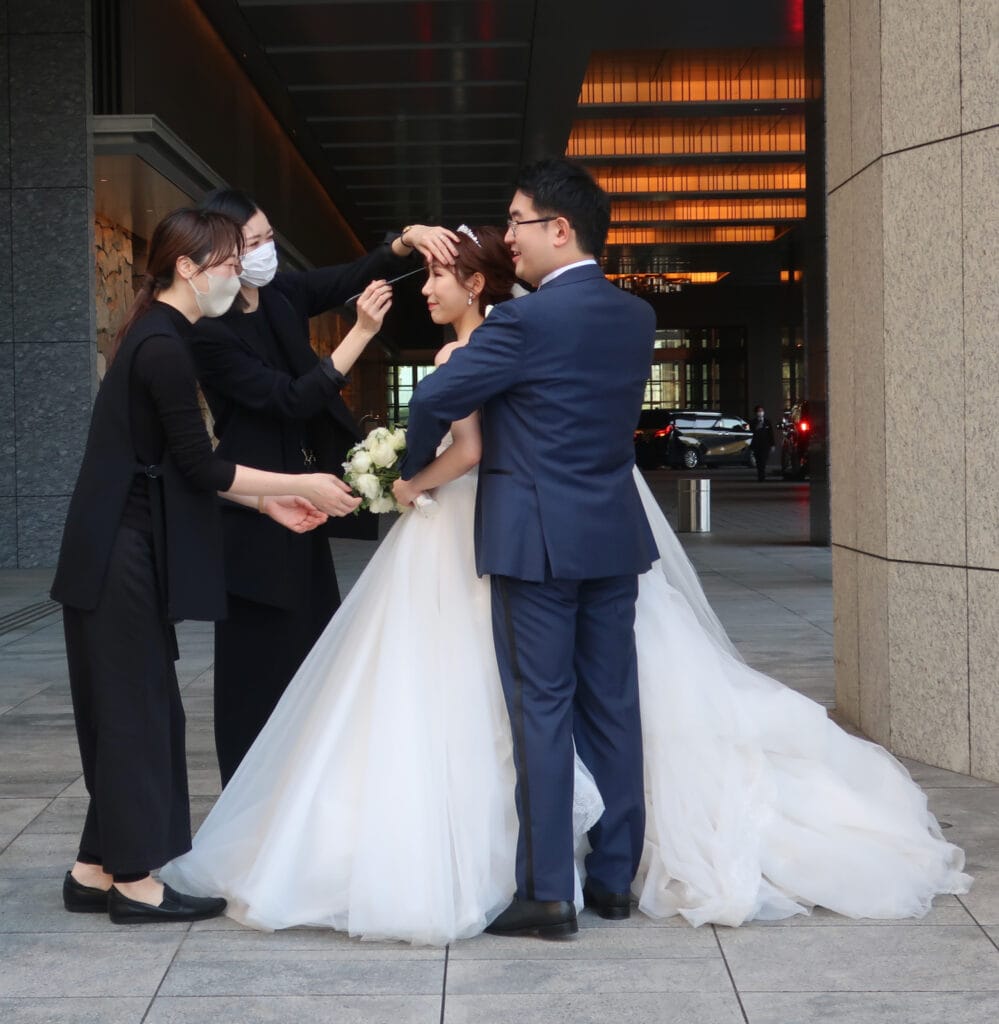
Springtime, when Cherry Trees burst into exquisite flamingo pink and white bloom, is arguably the most romantic time to visit Japan. During that time of year, there seems to be an engagement photo shoot or wedding procession around every corner.
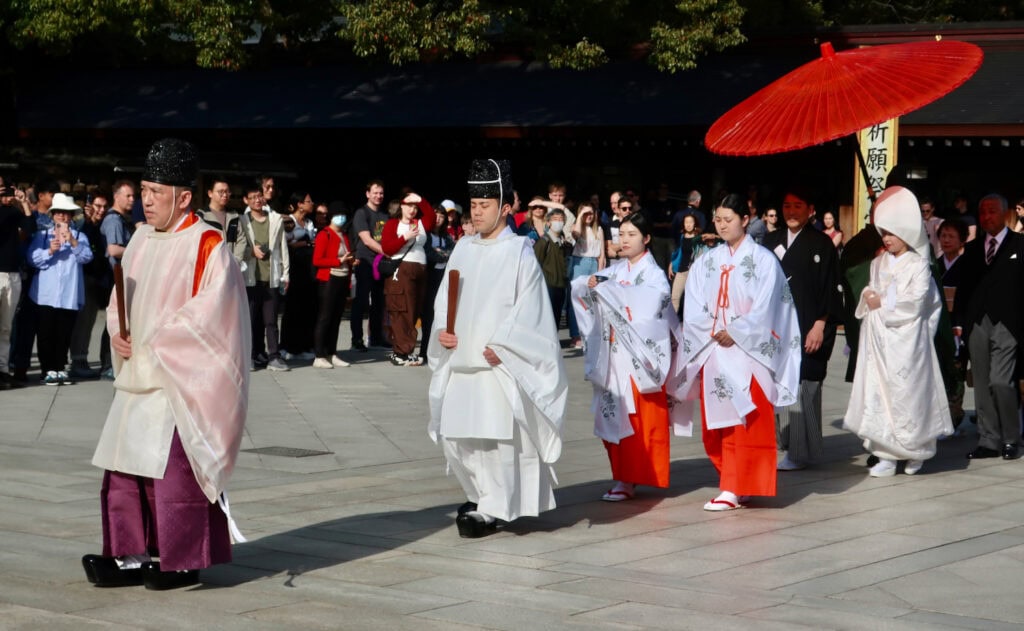
But, Springtime is also when Japan is bombarded with visitors – and those crowds could crowd you out of seeing your most yearned for spots. Just FYI.
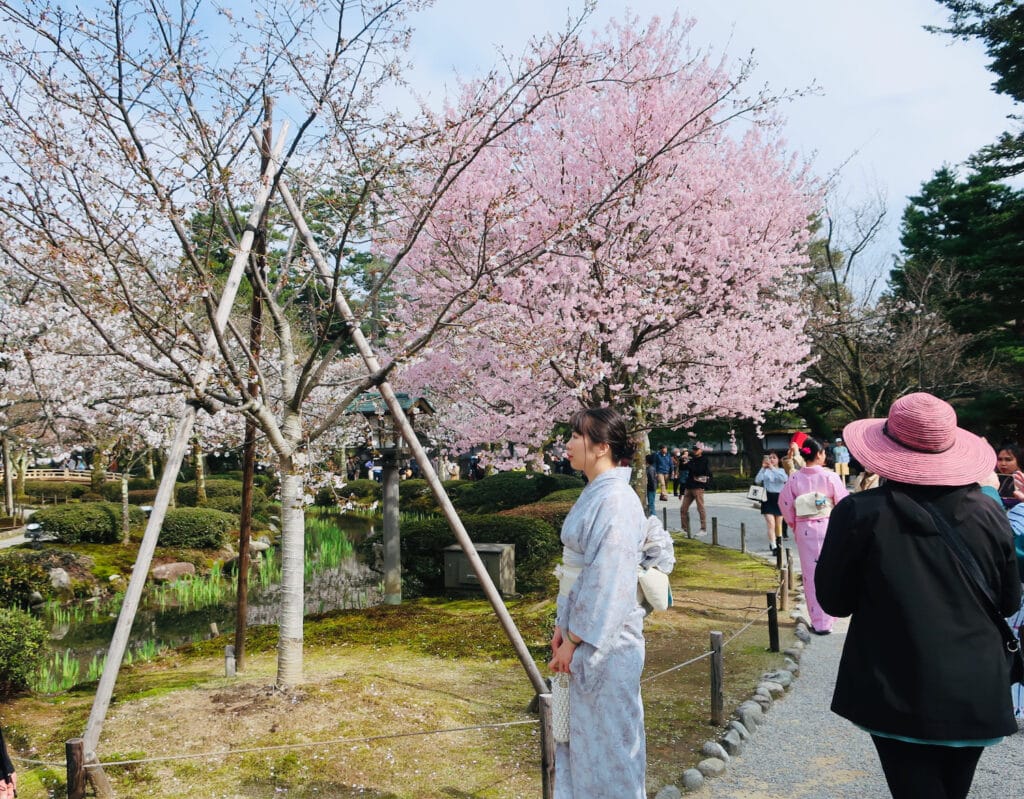
This Getaway Maven, fresh from a visit to the island nation of Japan, has recommendations, based on some very insider tips. While in no way an exhaustive list, or even a comprehensive one, the following Must Do’s cover a lot of ground – most of which you can visit via Japan’s excellent rail and bus system.
(For more “Great Escapes” around the world, check out these posts from Getaway Mavens).
Top Things to Do in Japan
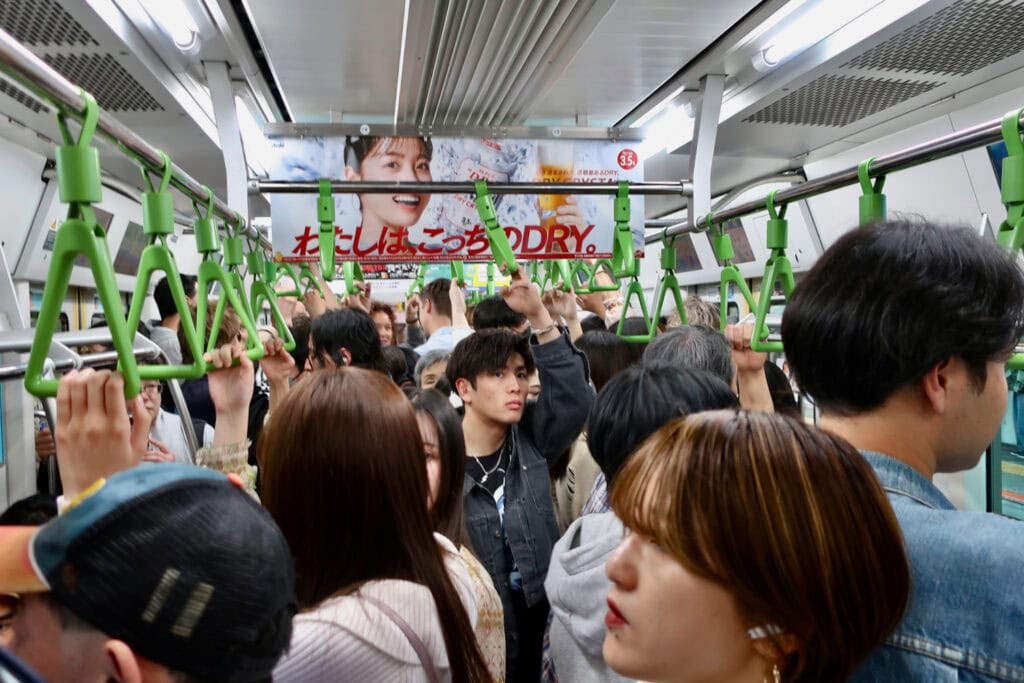
Tokyo
Try Riding the Tokyo Subway – At Least Once
It’s mayhem on Tokyo’s underground subway system. With pounding noise and unpredictable foot traffic, it coalesces into a scene that makes NYC’s Times Square seem tranquil and uncrowded in comparison. But don’t let that stop you from experiencing it at least once. Figure out your stop (ask someone at your hotel/hostel), find a ticket machine, and then feed your ticket through the electric “turnstile” (it comes out the other end – and you must keep it to get outside from your stop).
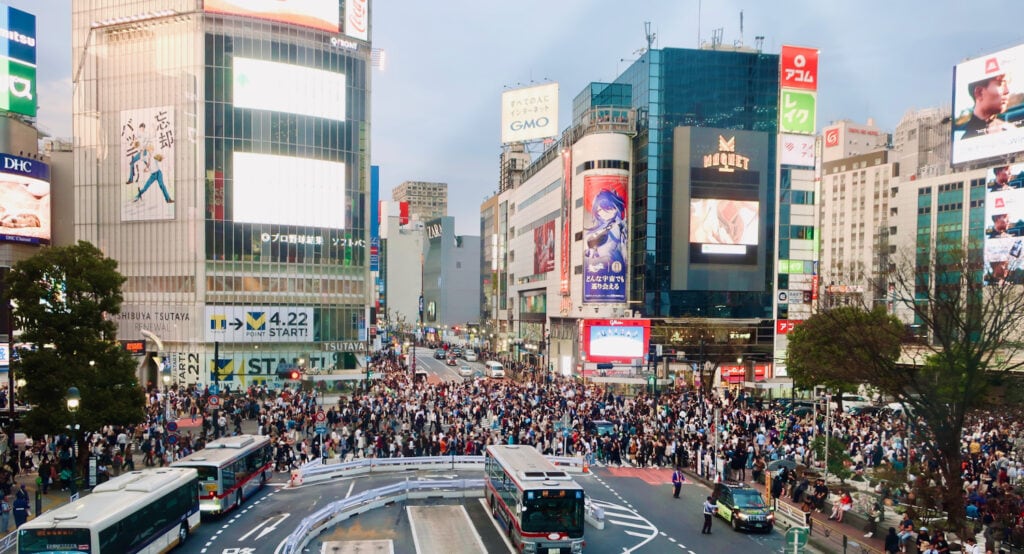
Join The Crowds at Shibuya Crossing – AKA “Crazy Crossing
An experience akin to being inside a stampeding herd of wildebeests on the African plains, you might be surprised by the civilized way nearly 3,000 people cross the major Shibuya Crossing intersection at once.
It’s not enough to be in the midst of it, though. Afterwards (or right before), take the escalator to the 2nd floor of the Shibuya Scramble Square Building for an elevated view, no ticket required. (However, you will need a ticket for the 47th floor Shibuya Sky observation deck –too high to really get a feel for the action below).
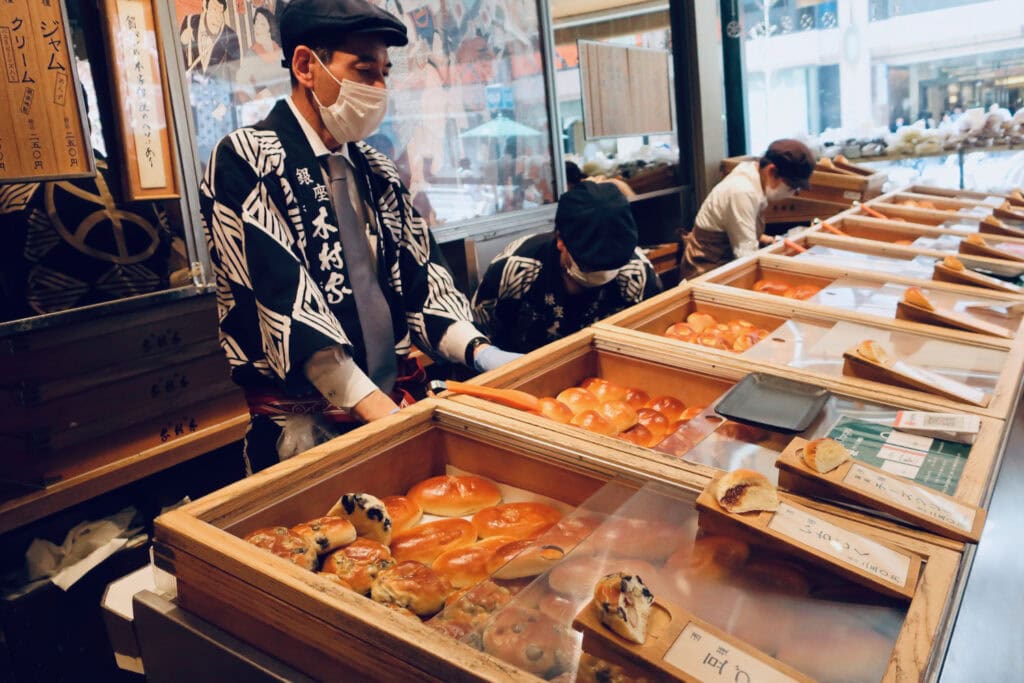
Buy a Stuffed Bun Fresh From the Oven at Kimuraya bakery in the Ginza Section of Tokyo
Ginza is Tokyo’s most upscale shopping district, with every conceivable fashion designer represented. When you tire of shopping (or, in most cases, window shopping) pick up a snack at Japan’s 150-year-old bakery, Ginza Kimuraya.
Established in 1874, Ginza Kimuraya is said to be the oldest bakery in Japan – and notable as the originator of the soft filled bread roll called anapan: the Krispy Kreme of bread rolls.
If you’re tempted to eat it right away, just be aware that there are no litter bins on Japanese streets – forcing you to eat street food in place. Locals frown on tourists walking and chowing down.
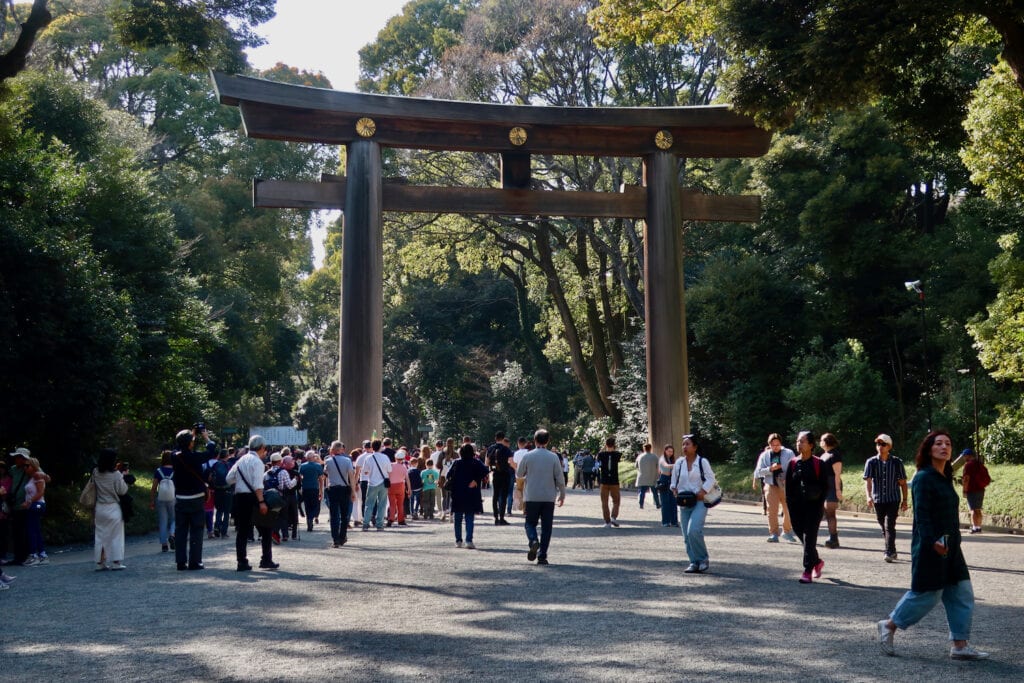
Go Back in Time to Ancient Tokyo at the Meiji Jingu Shrine
Visit the famed Meiji Jingu Shrine, a peaceful enclave of temples and gardens dedicated to late 19th-century Emperor Meiji and his wife. Built in traditional Shinto style with low wooden buildings ringed by square courtyards and lovely woods, the shrine is one of Tokyo’s most popular attractions.
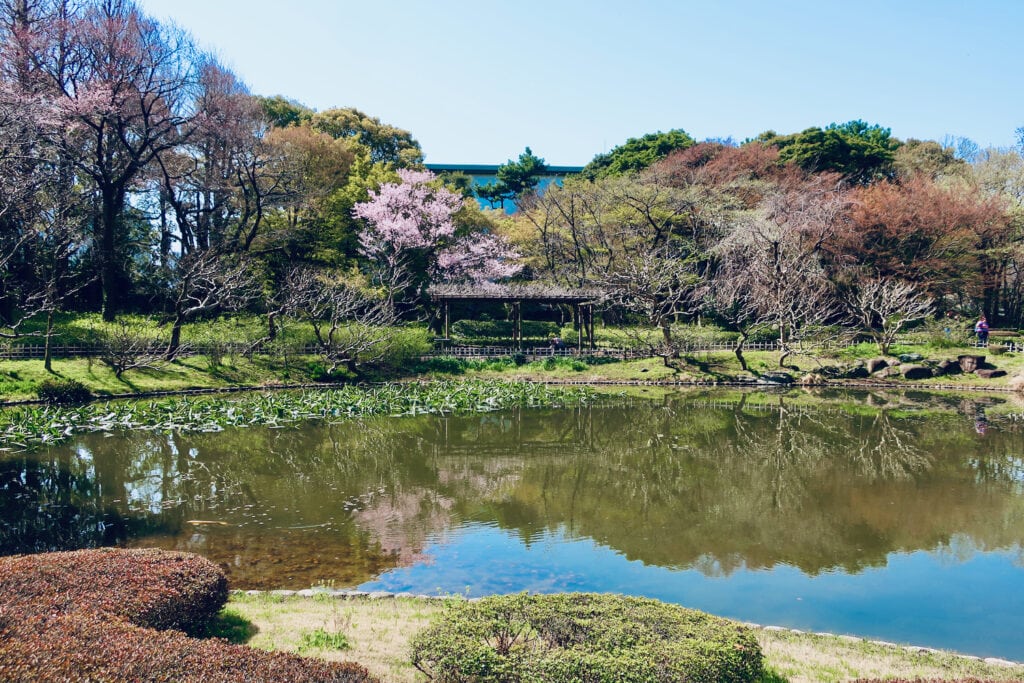
Yes, Japan Still Has An Emperor: And He and His Family Live in the Imperial Palace, Tokyo
Japan’s Imperial Palace, Kokyo, home to the Imperial Family, is surrounded by moats and ramparts. The huge complex dates to the 15th century, when territorial disputes required massive fortifications, and elaborate palaces reflected the high positions of the feudal lords.
Nowadays, only the highest on high world dignitaries are allowed inside the Palace, but that’s OK, because you’ll want to visit the East Gardens, part of the innermost circle of defense of the historic Edo Castle that once stood here.
There, you’ll find an asymmetrical garden with blooming trees, rock formations, and koi ponds filled with colorful, ornamental carp – all the elements of traditional Japanese landscaping.
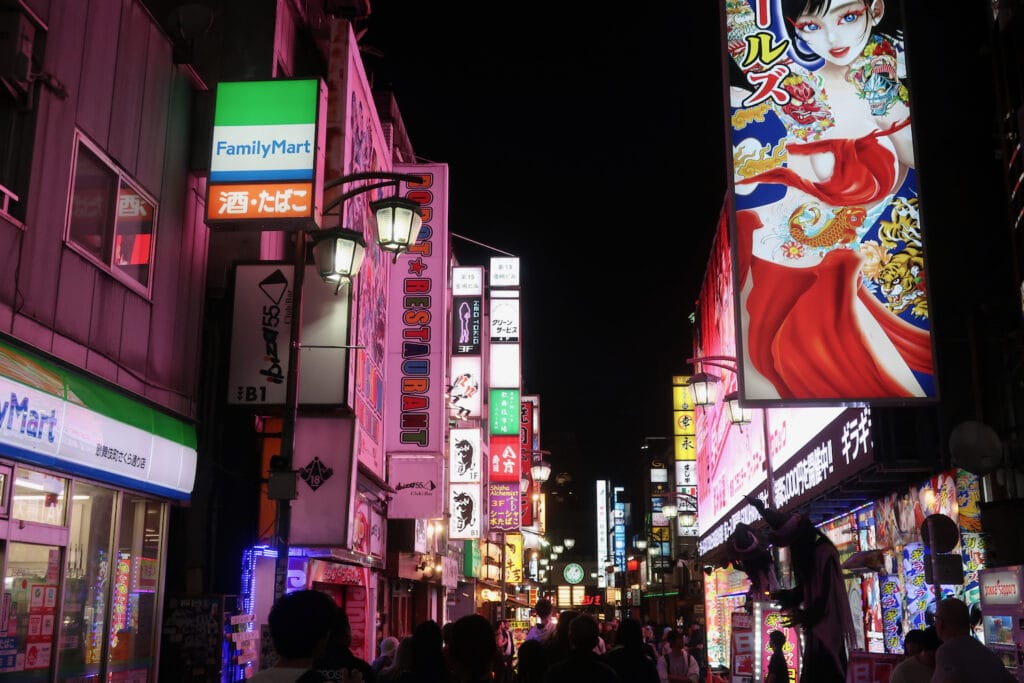
Spend an Overstimulated Evening (or just Few Wild Minutes) in Tokyo’s Red-Light District: Shinjuku Kabukicho
There are Women’s Clubs (and of course, Men’s Clubs) aplenty in this bright as day nighttime playground for sexy time. This is where generally modest cultural norms are thrown out the window, with all fetishes catered to: from anime to normies. All the while, hyper-realistic videos flash constantly on skyscraper screens. The whole effect is like being inside a pinball machine.
Best Things To Do In The Rest of Japan
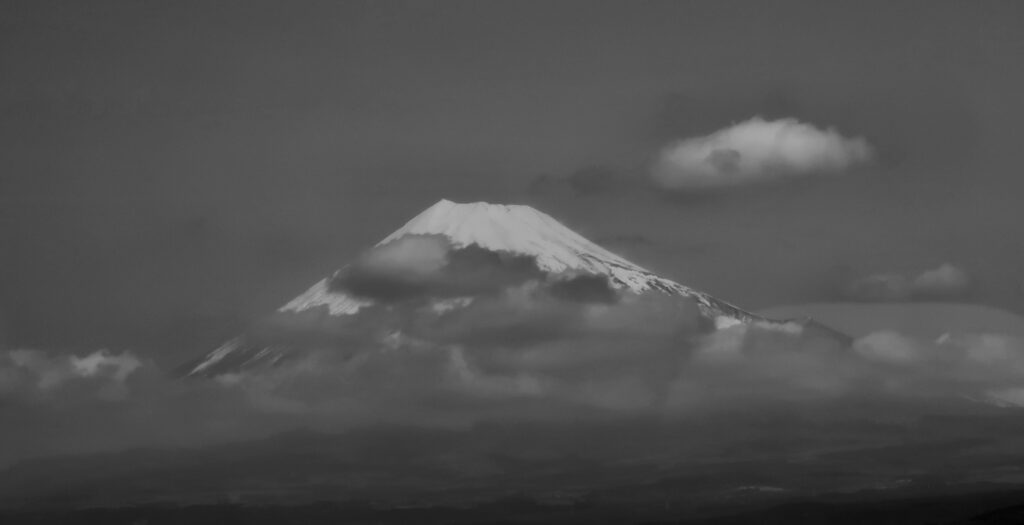
Take a Requisite Photo of Mount Fuji at Fuji-Hakone-Izu National Park
(2 to 2 ½ Hours from Tokyo by train or bus)
The almost perfectly symmetrical Mt. Fuji, one of the most photographed sights in Japan, if not the world, stands 12,388 feet high. Learn about the environmental and conservation efforts on the mountain at the Mt. Fuji World Heritage Center in Fuji-Hakone-Izu National Park.
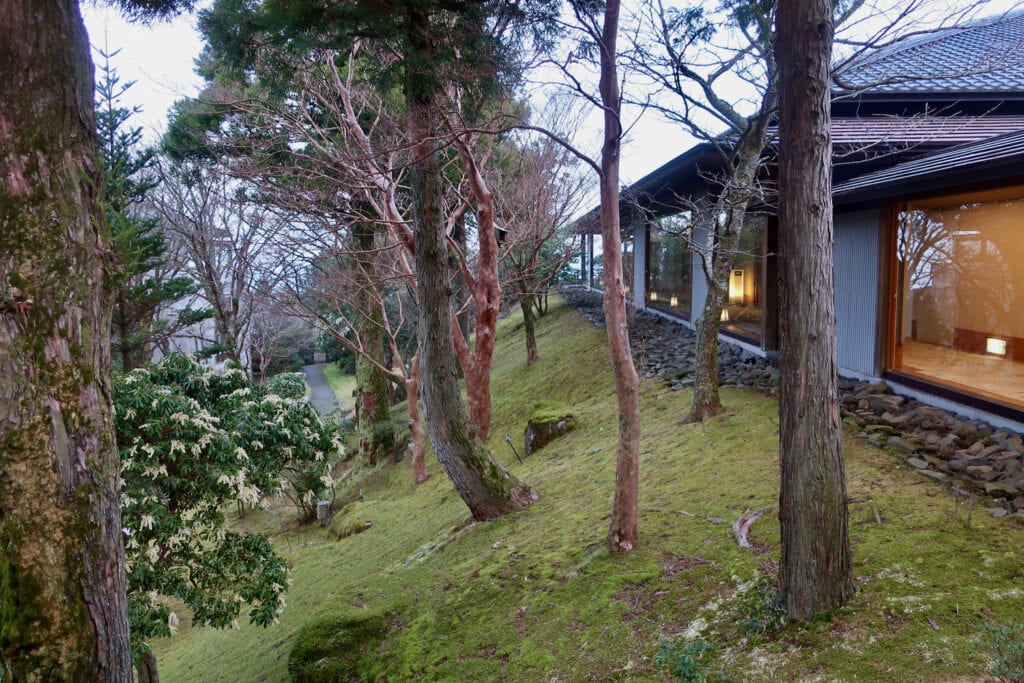
Stay in A Traditional Ryokan In Japan’s Thermal Springs Region (At Least One Night)
The town of Hakone and this region of Japan overflows with hot-spring (onsen) resorts, and has been a tourist magnet for centuries. Stay in a traditional, minimalist Japanese-style room (read: on a slim mattress on the tatami-mat floor), where you remove your shoes before entering.
Be aware that you must strip down completely before entering the communal onsen baths (men and women separated), but self-consciousness seems to melt away in the restorative waters.
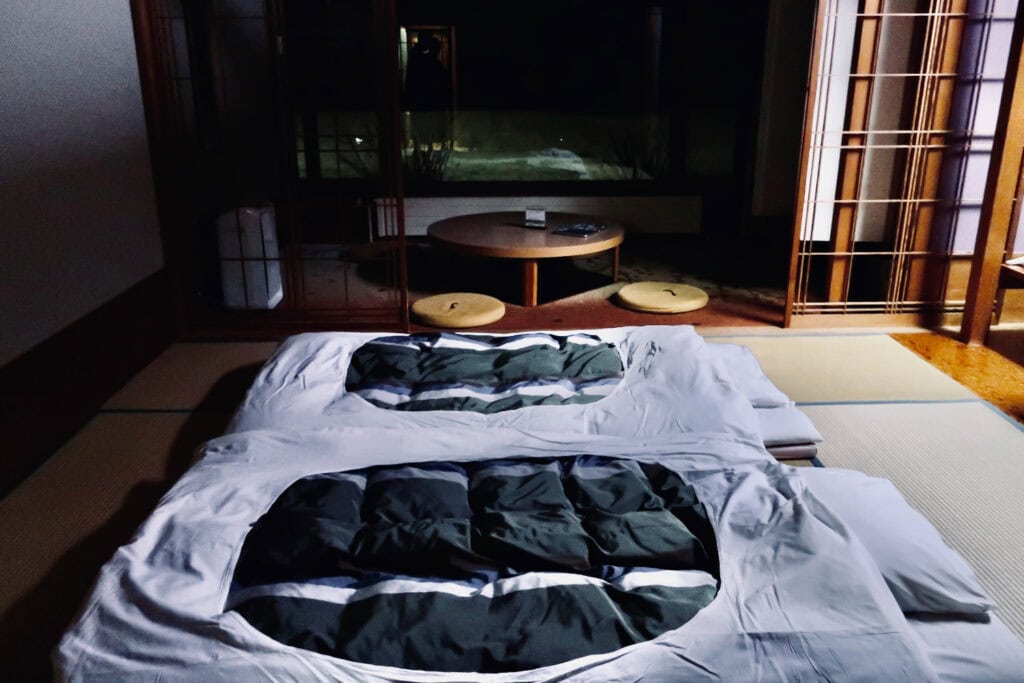
There are hundreds of ryokans in Japan, from rustic to luxury, with and without onsens. If planning a Japan trip yourself, this Japanese Guest House website can help steer you. I stayed in one of the more upscale ryokans: the Hakone Yunohana Prince Hotel, with beautiful grounds, large rooms, indoor and outdoor onsens, a great restaurant, and attentive staff.
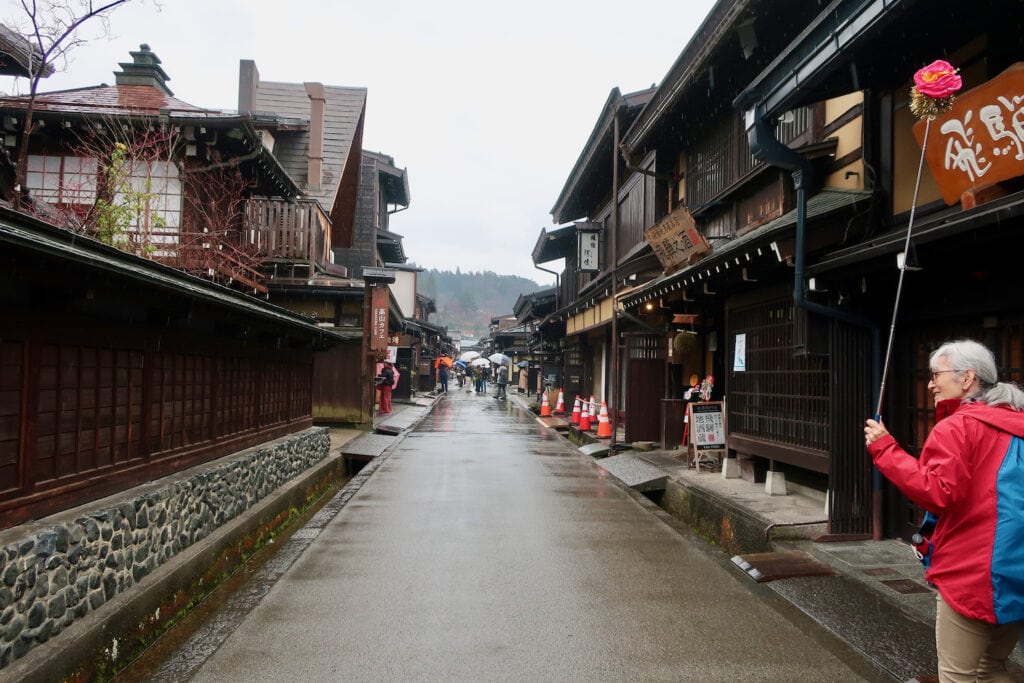
Wander the Old Takayama District In Mountain Town of Takayama And Visit A Sake Brewery
(5-7 hours from Hakone on Bullet plus Limited Express Trains)
Old Takayama is a beautifully preserved neighborhood, with historic buildings that date back to the Edo period, 1600 to 1868. The Old Takayama District is comprised of three narrow streets in the San-machi-suji district, where in feudal times, wealthy merchants lived amidst the authentically preserved small inns, teahouses, peaceful temples, and sake breweries – some of which have operated for centuries. Visit one of these breweries to taste the variations of this national beverage and learn about the unique Japanese brewing methods.
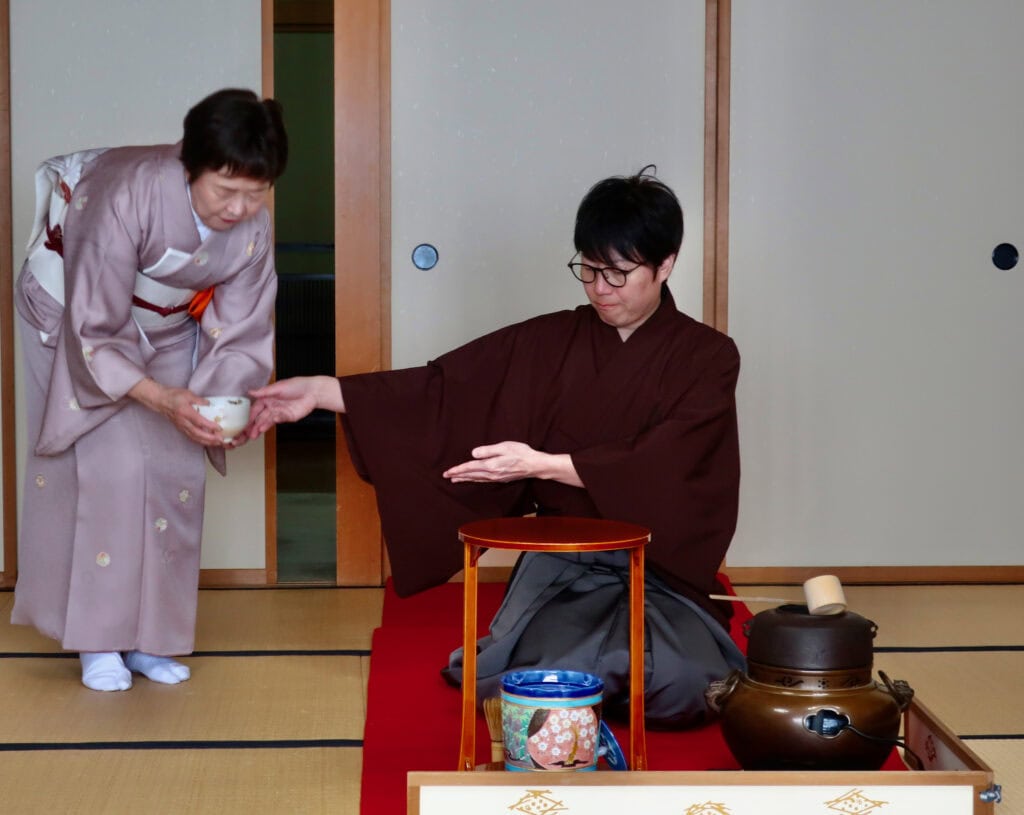
Experience a Traditional Tea Ceremony, Takayama
Attend a traditional Japanese tea ceremony to learn about this 12th century style of prepping and serving tea: notable for its multiple exacting, and wonderfully artful, steps.
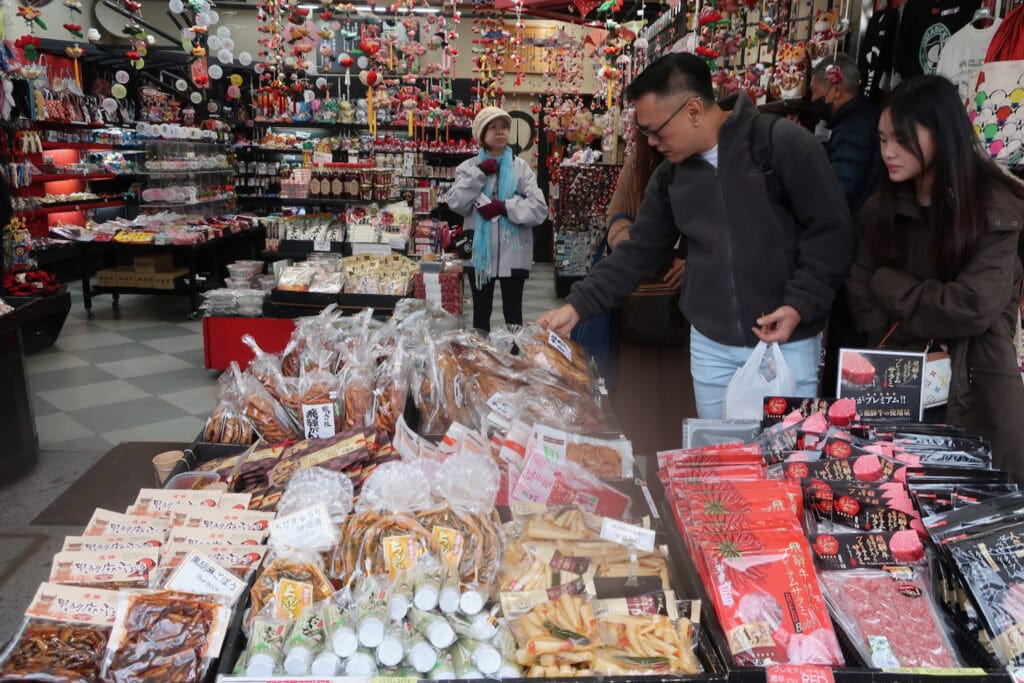
Buy Crafts and Local Treats at Takayama’s Miyagawa Morning Market
At Takayama’s centuries-old Miyagawa Morning Market along the riverfront, stall owners sell everything from fresh fruit, vegetables, and flowers to pickles, crafts, and fish. In season, try the bright red strawberries. You won’t find better anywhere else.
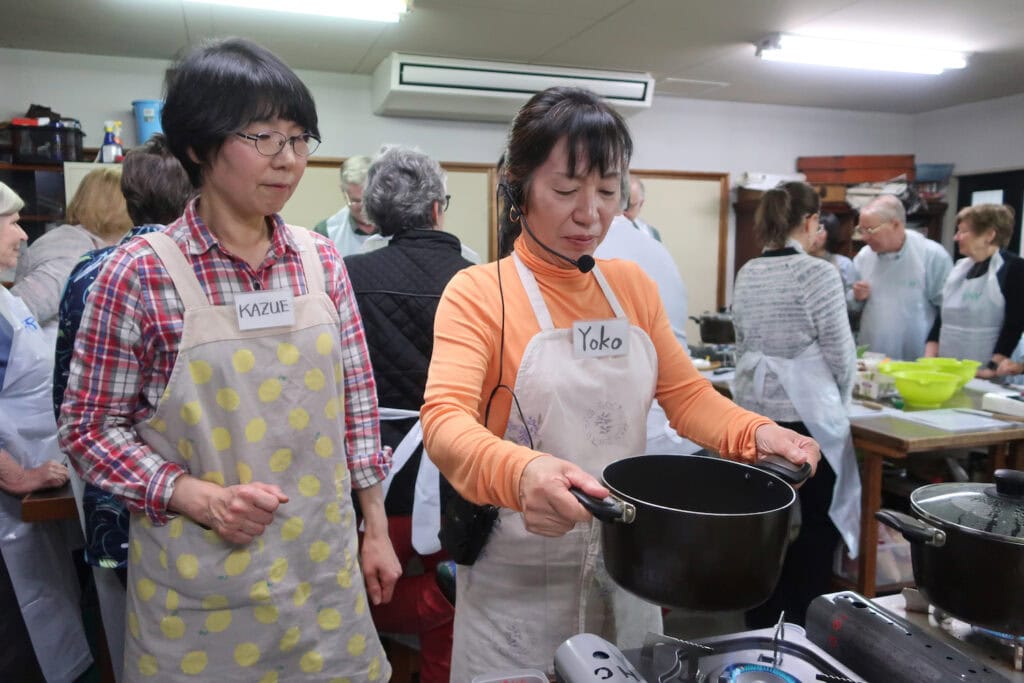
Take An Authentic Cooking Class From Fun and Funny Local Takayama Women Who Cook For Their Families Every Day
Run by a woman named Yoko, this hands-on cooking class (Hida Cooking Class) in Takayama is well organized, not to mention a hoot. Instructors reassuringly offer straightforward directions, so you can’t really mess up. You’ll eat what you make: all incredibly delish. Good thing you’ll leave with recipes.
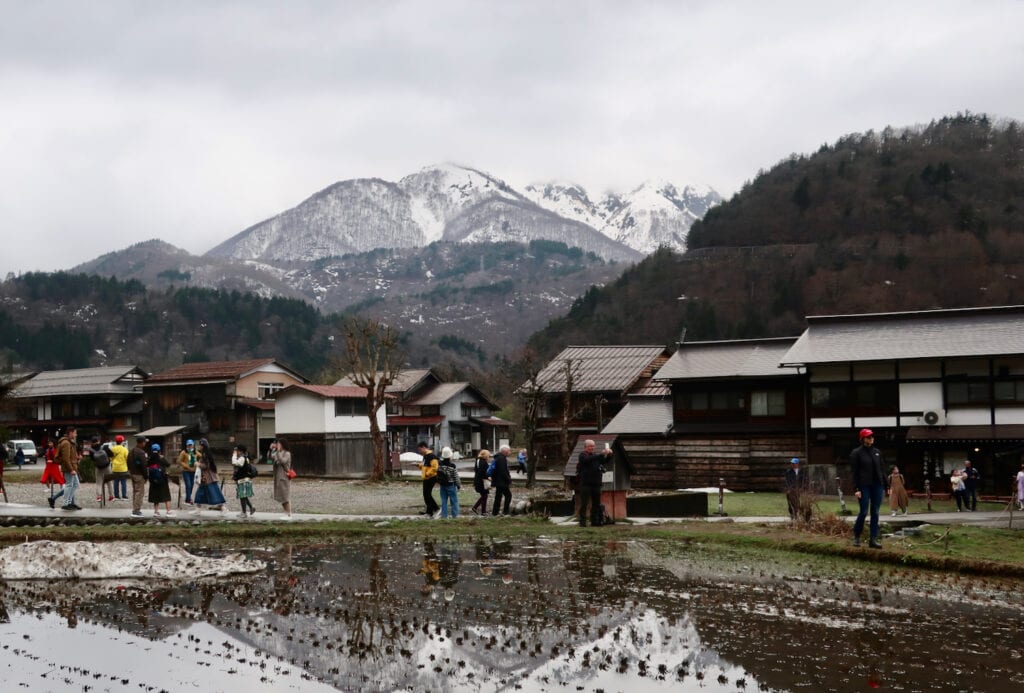
Gape At the Thatched Roof Homes in Shirakawa-go Village, a UNESCO World Heritage Site
(One Hour by Bus from Takayama to Shirakawa-Go Village)
Comprising traditional thatched-roof homes, the UNESCO Shirakawago-Go Village is a vibrant community whose residents work together to preserve the Gassho architecture style unique to this region: wooden houses with steep thatched roofs built to withstand heavy snow.
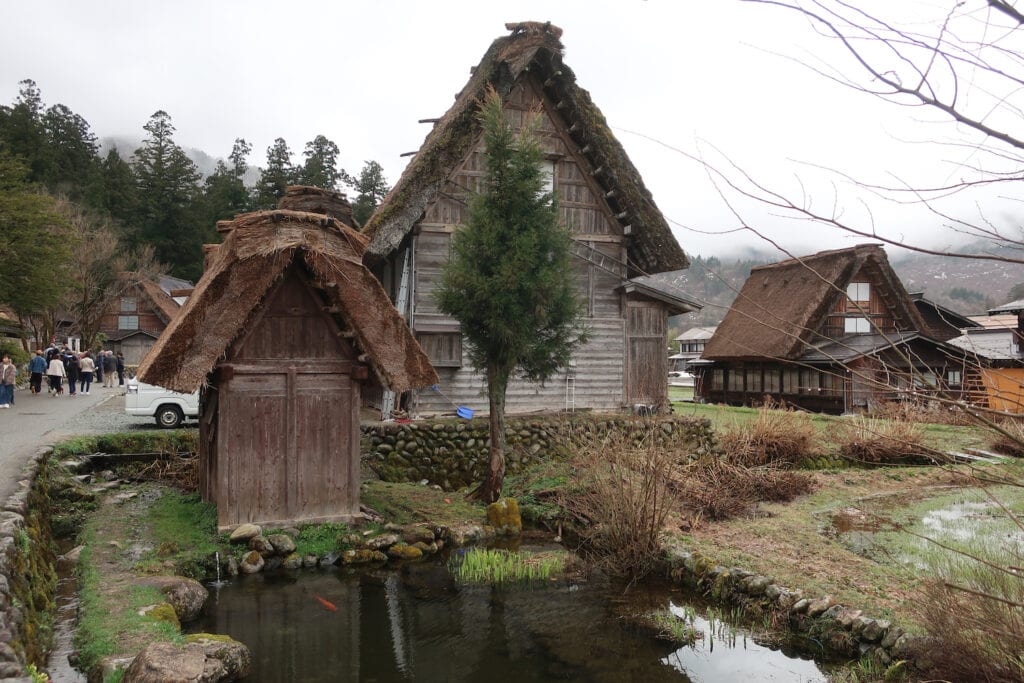
Wander around the cluster of 59 houses, preserved to show how its inhabitants lived long ago. And then enter one of the residences to learn about this labor-intensive architecture style, which, even today, is deceptively sophisticated.
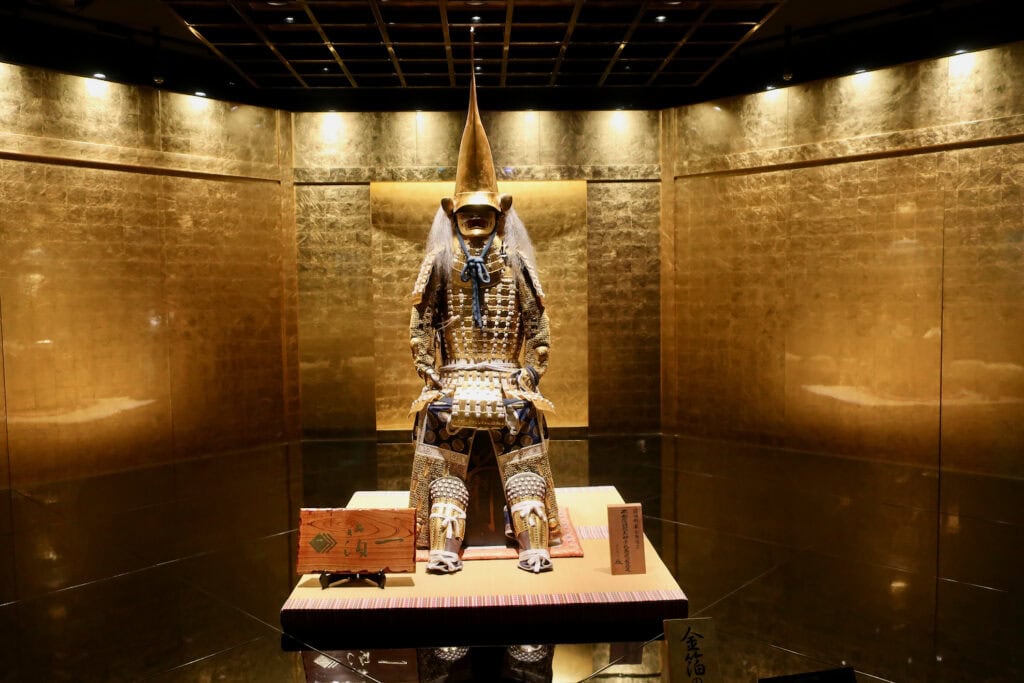
Eat A Gold Leaf Ice Cream Treat at the Hakukokan Gold Leaf Center in the Mountainous Town of Kanazawa
(Bus 1.25 Hours from Shirakawago Village to Kanazawa)
Kanazawa survived the ravages of World War II because of its out-of-the-way location between the mountains and the Sea of Japan. Though somewhat off the beaten tourist path, Kanazawa is prized among Japanese as the country’s best-preserved Edo-period city (along with Takayama).
The Hakukokan Gold Leaf Center celebrates the art and craft of gold leaf technology with a collection dating to the late 16th century. A center of gold leaf craft, Kanazawa produced most of the gold leaf in the country including hundreds of thousand sheets for the restoration of the Golden Pavilion in Kyoto (read below).
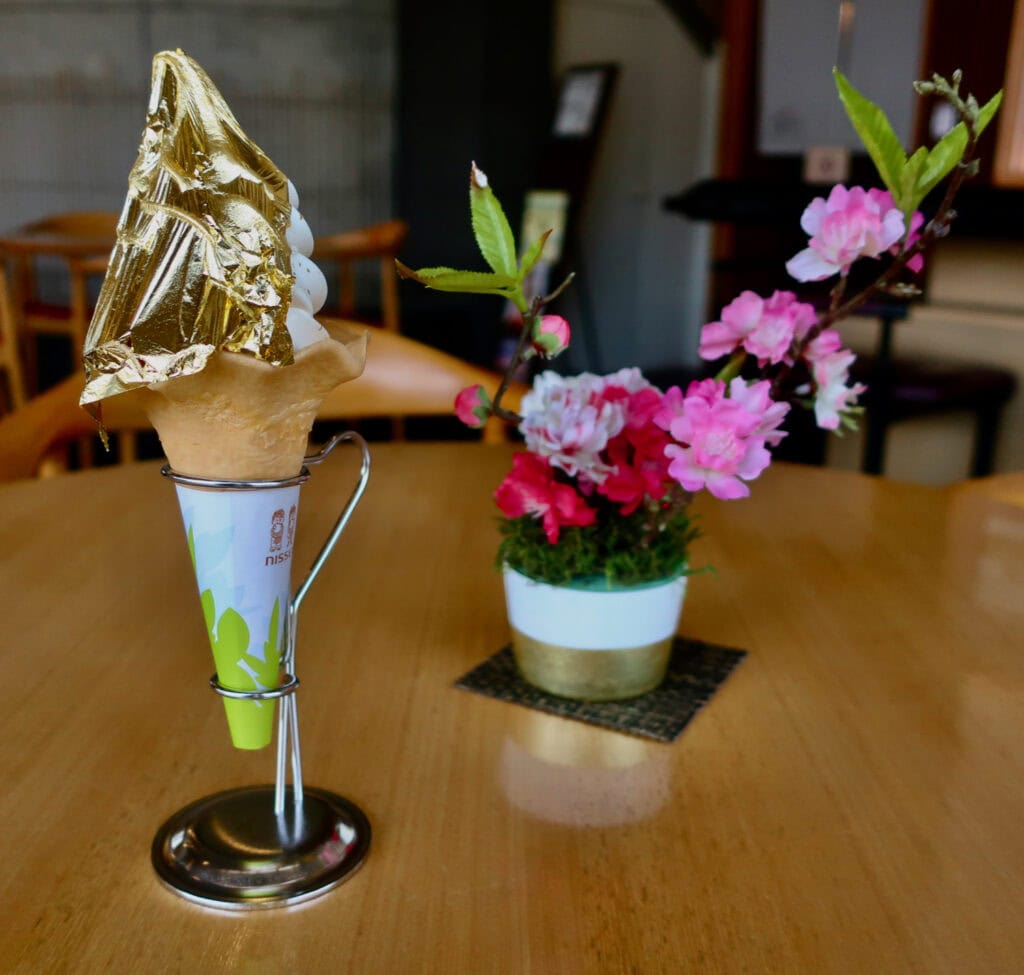
The process of beating gold bars into gold leaf was and still is arduous – and dangerous – which you’ll see on a tour of the museum.
If available, sign up for a “make and take” gold leafing project, allowing you to create your own small, gilded plate. Or, just peruse the well-stocked gift shop, which includes gold-flecked lotions and soft-serve vanilla ice cream sheathed in edible gold leaf.
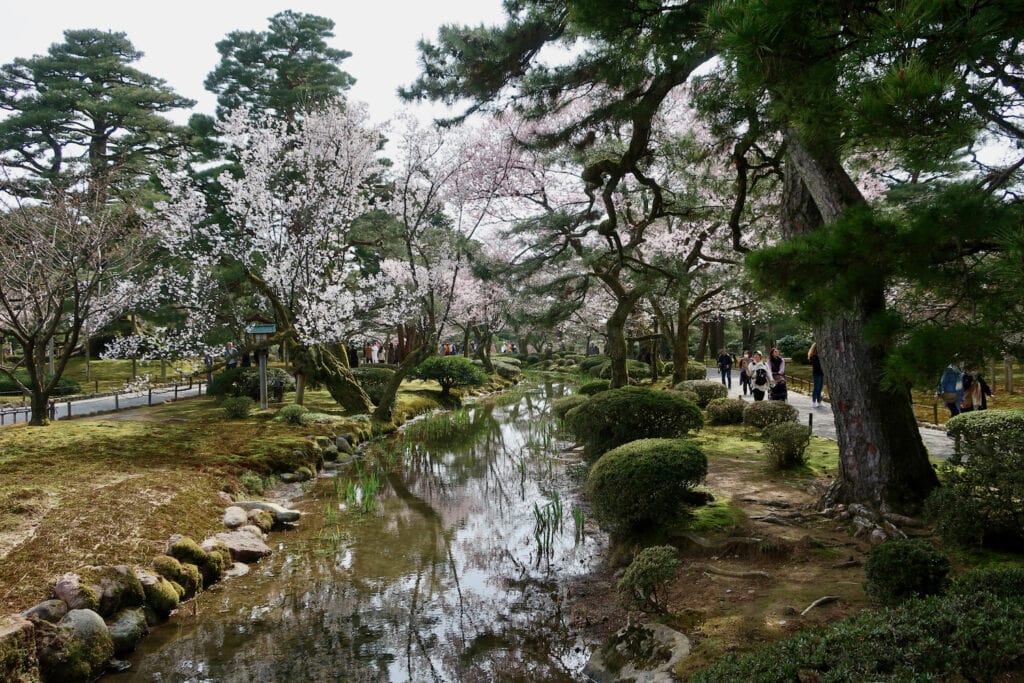
Walk The Grounds of the Exquisite Kenrokuen Garden: A National Landmark Dating to 1676, Kanazawa
One of Japan’s three finest traditional gardens, Kenrokuen (Garden of Six Attributes), represents the six qualities required for the perfect garden: extensiveness, artifice, antiquity, waterways, panoramic views, and quiet seclusion.
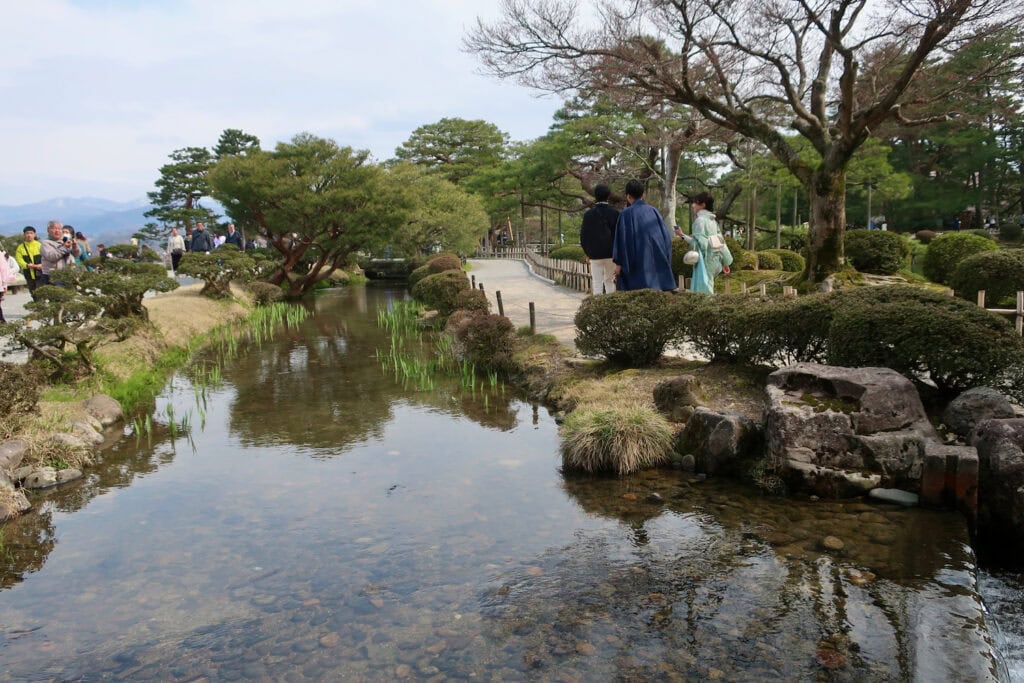
Its trees, ponds, waterfalls, and flowers stretch over grounds of 25 acres. I cannot describe how achingly gorgeous this place is: with photo ops around every corner, from every vantage point.
Roam The Higashi Chayagai Area of Kanazawa
With its historical row of teahouses, beautiful lattice homes, and maze of continuous alleys, it’s full of charm and beauty.
Visit These Five Buddhist Temples, Shinto Shrines, Palaces, and Gardens (Out of Thousands) in Kyoto
(2-hour Train from Kanazawa to Kyoto)
Kyoto has been Japan’s Imperial Capital for a millennium and is now the country’s cultural and artistic capital. You can spend a year exploring all 1,600 temples, hundreds of shrines, three imperial palaces, and sumptuous gardens and forests. But you can visit the following in a few days:
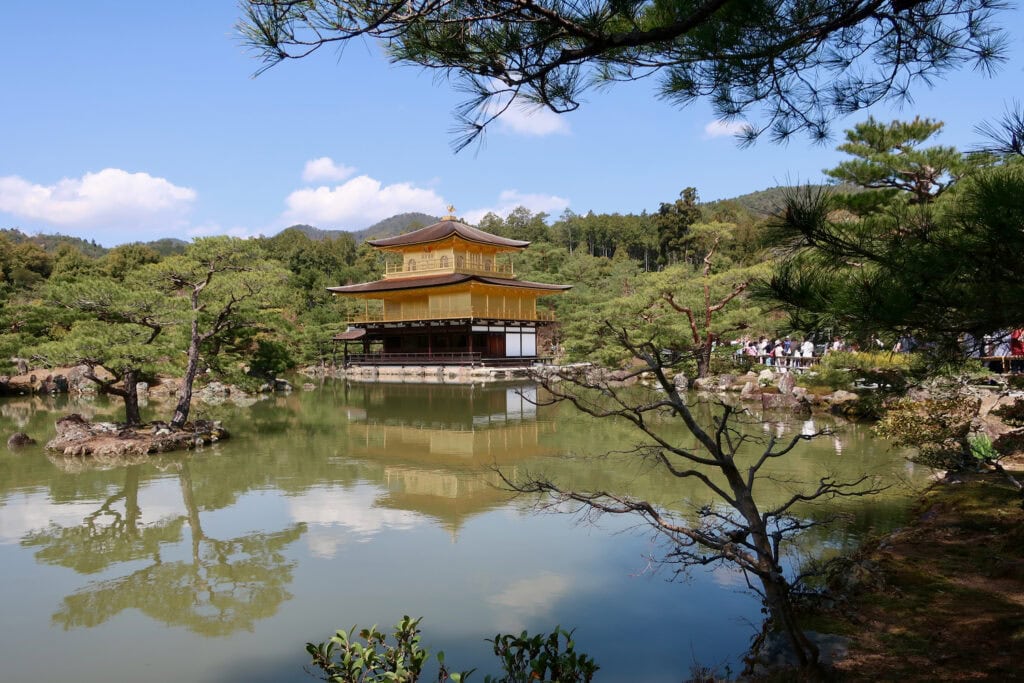
Kinkaku-ji Temple (also known as The Golden Pavilion)
This Zen Buddhist temple is one of the most famous buildings in Japan. The lakeside Temple of the Golden Pavilion was originally constructed in the 14th century as a retirement villa and later converted to a temple. It stood for 600 years until it was burned to the ground by a young, mentally ill monk in 1950.
The temple has since been reconstructed following the original design, including the three distinct styles of architecture – the shiden, samurai, and zen – and is covered in gold leaf from Kanazawa all the way up to the upper floors. Its setting on pillars suspended over the water makes it one of Kyoto’s most inspired – and inspiring – sights.
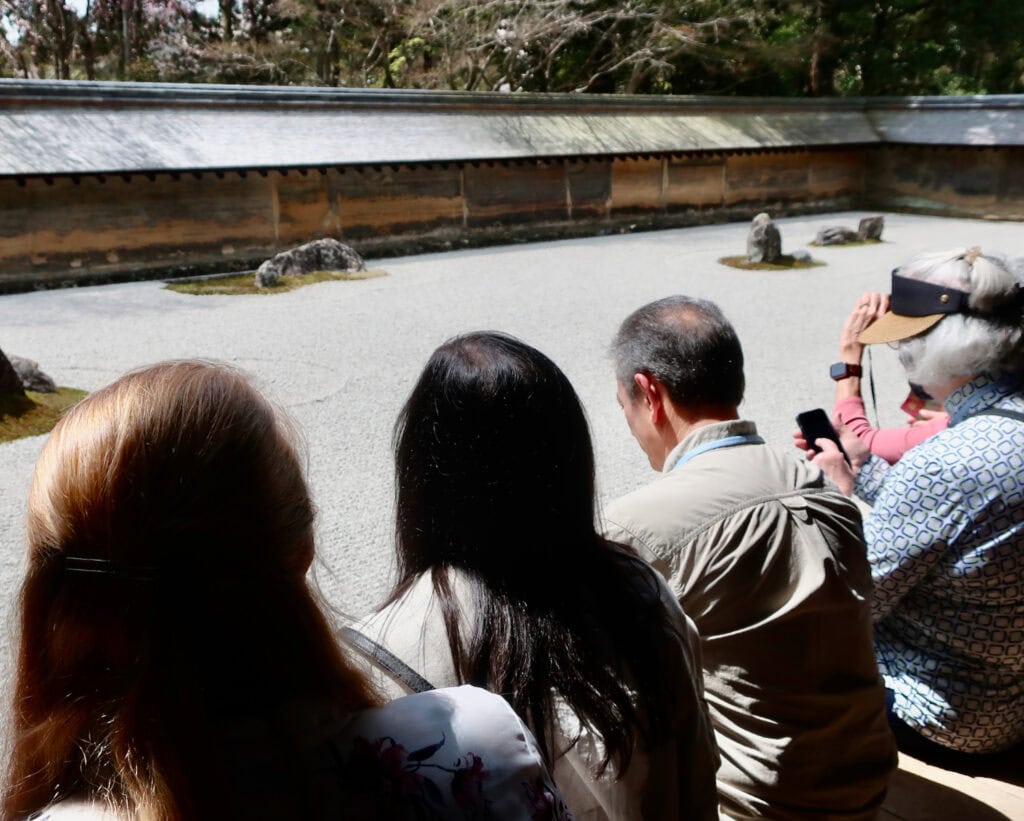
Ryoan-ji Zen Buddhist Temple
See the Ryoan-ji’s famous rock garden, a rectangular plot of pebbles with 15 large rocks laid out in groups and sitting on patches of moss. Interestingly, the small-scale garden was designed for only 14 rocks to be visible at one time, no matter where the viewer sits or stands. To this day the meaning of the garden’s design is unclear, but many believe it is supposed to inspire peace and contemplation.
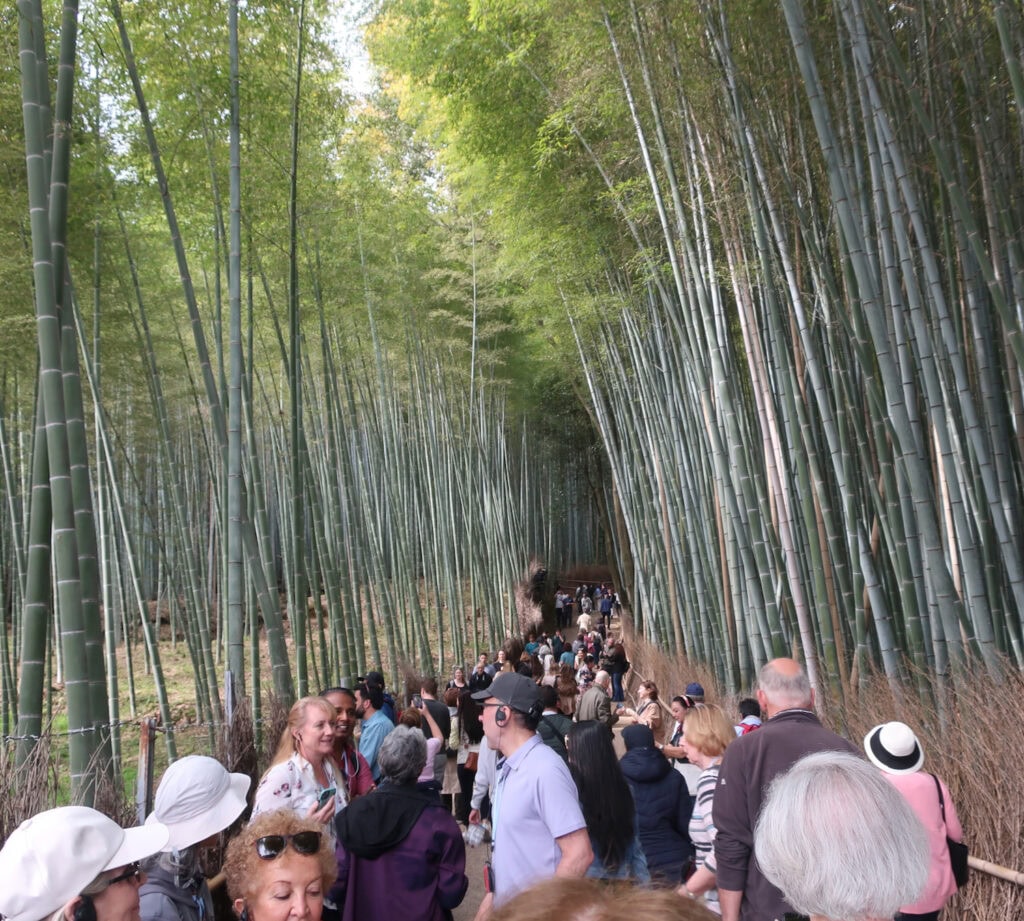
Arashiyama Bamboo Grove
Join the ebullient crowds sheltered by thousands of smooth, towering bamboo plants in the Arashiyama Bamboo Grove. You’ll feel very small within this otherworldly natural bamboo forest, where the leafless stalks can reach 100 feet or more into the sky.
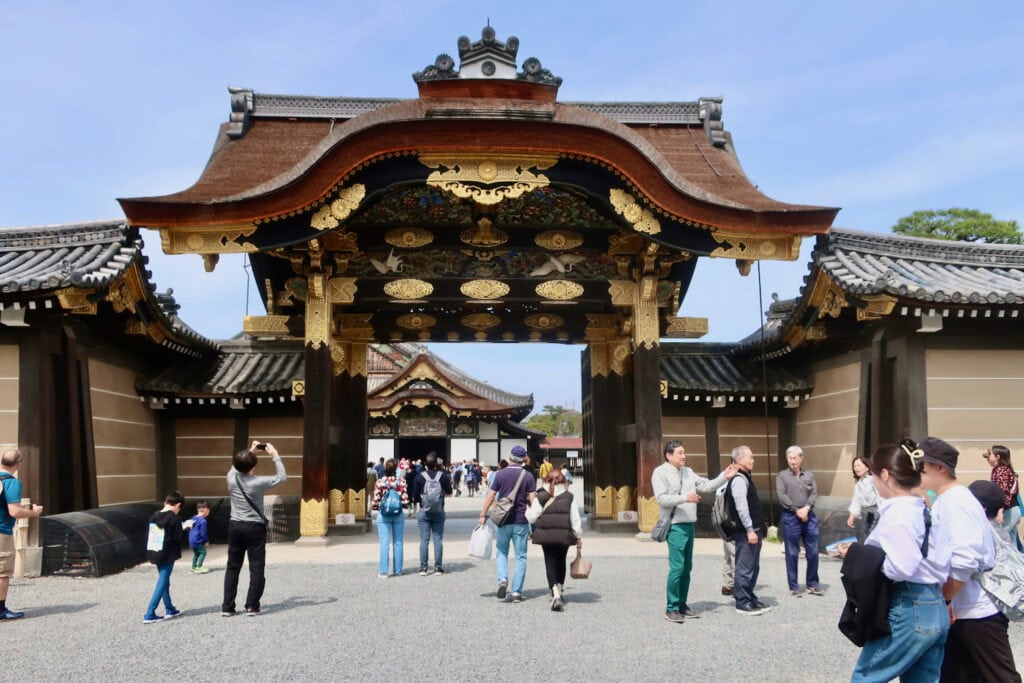
Nijo-jo Castle
Have you been watching the Hulu Series, Shogun? Then, Nijo-Jo Castle will surely look familiar to you. (Although due to Covid, the episodes were actually filmed in Canada and on stage sets).
Built in 1603, this was the extravagant residence and fortifications of the shoguns who ruled Japan for more than 250 years. Featuring imposing stone walls and deep moats, the castle has many interior security measures as well, including hidden rooms for the shogun’s bodyguards and chirping “nightingale floors” which squeak when stepped on to alert occupants of intruders.
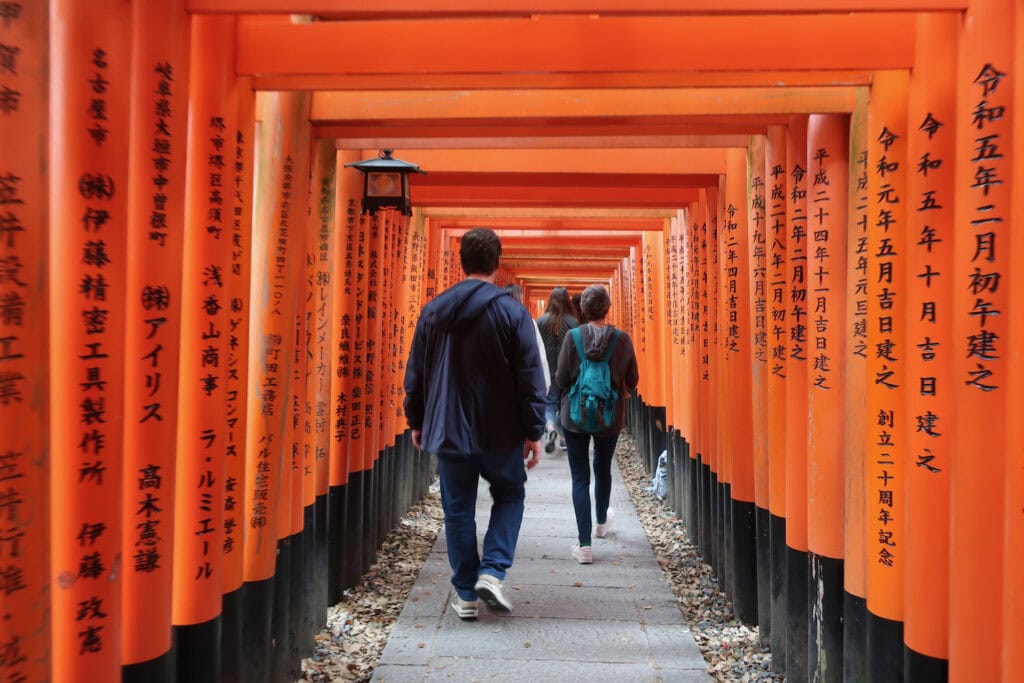
Fushimi Inari Shinto Shrine
The Fushimi Inari Shrine’s 2.5 miles of mountainside trails are straddled by roughly 1,000 bright orange torii gates (that served as template for Cristo’s Central Park installation – f – years back).
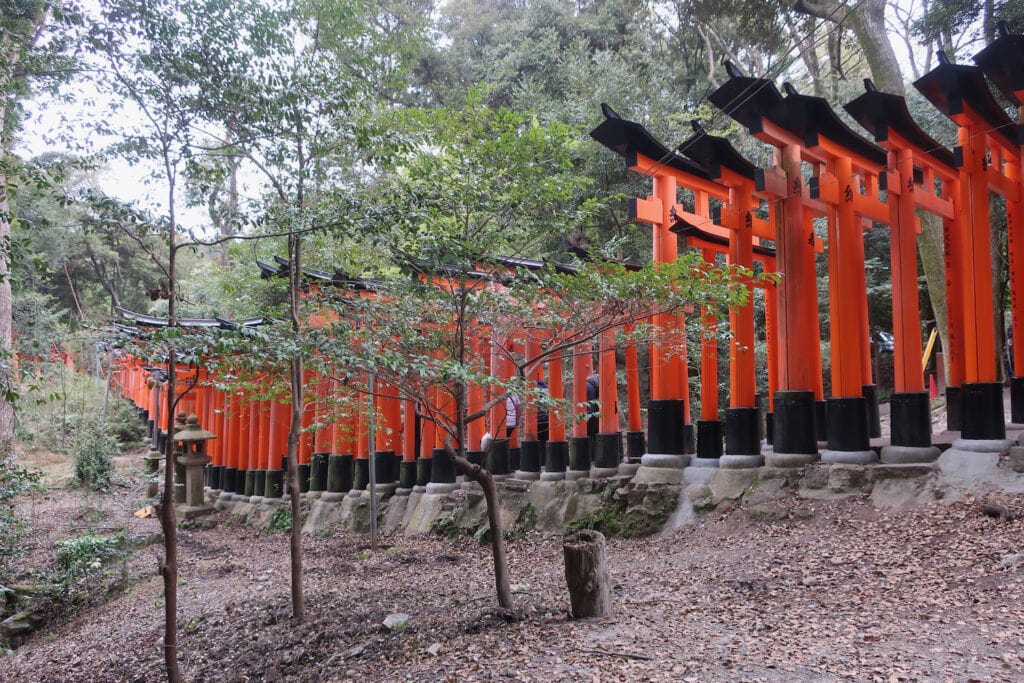
You don’t have to walk the full 2.5 miles, but definitely make your way though the larger and then smaller gates, and then back through parallel sets of gates on the other side. Try to bypass all the Insta-Darlings, and just get lost in an aura of Zen serenity.
Sanjyusangendo Hall
First built by the famous warlord Taira no Kiyomori for Emperor Go-Shirakawa in 1164, and rebuilt after a fire in 1266, this important Buddhist temple houses an impressive 1,000 statues of the Thousand Armed Kannon goddess of compassion. An uncanny sight, they stand sentry, arrayed in rows above 28 sculptures of Buddhist guardian deities.
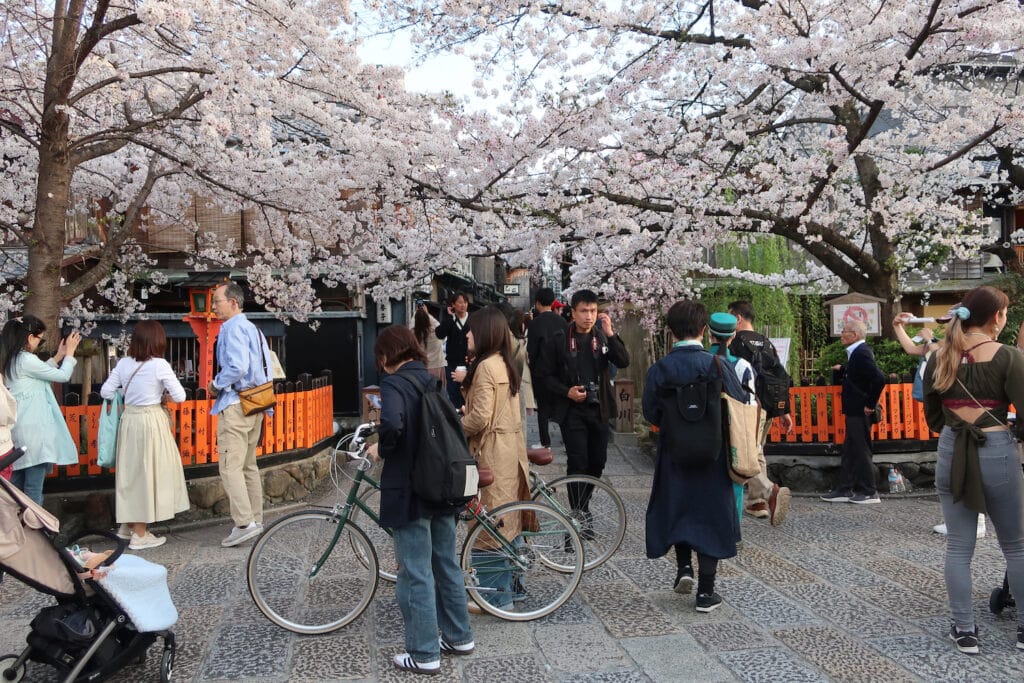
Wander The Geisha District in Kyoto And Watch A Traditional Arts Performance
It’s nearly impossible for the average tourist to enter exclusive Clubs, tucked behind multiple closed doors, where geisha’s entertain guests (mostly businessmen – a throwback, to the Mad-Men era). But a meander through the Geisha District in Kyoto might lead to sightings of these poised, extravagantly kimonoed women.
Learn about the art of being a Geisha (and other Japanese traditions) by watching a performance at Gion Corner theater. This show offers a 50-minute overview of traditional Japanese Arts: from the tea ceremony, to flower arranging, puppetry, comedy, and the slow, graceful, and absorbing dance performed by fully costumed Geishas. Buy tickets early as they tend to sell out quickly.
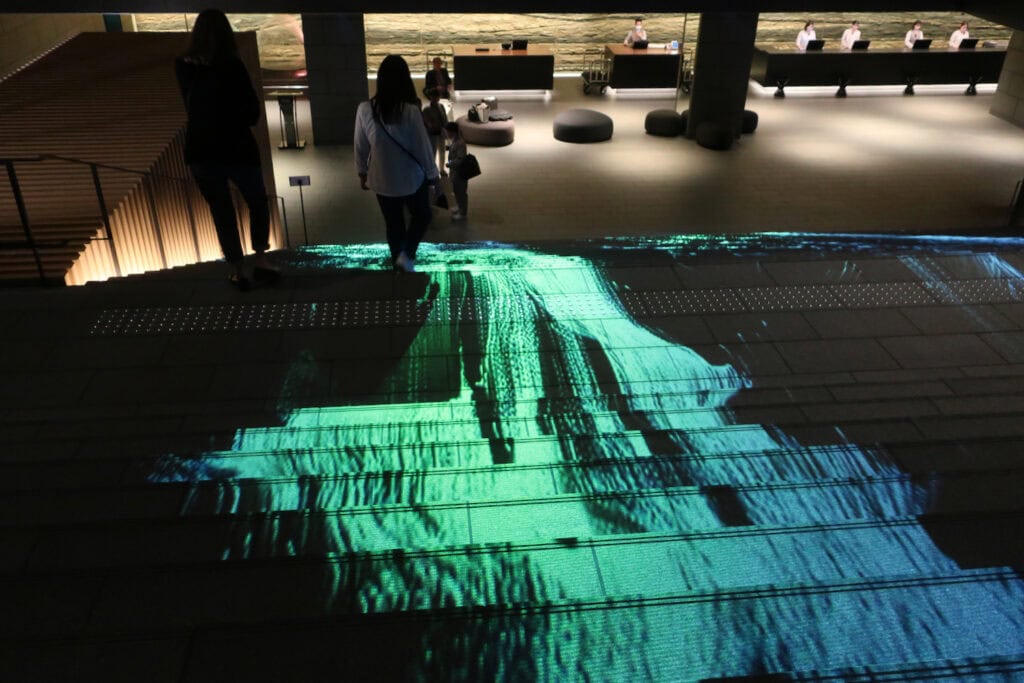
Splurge on a Stay at The Thousand Kyoto
Even if you have to stay in hostels during your time in Japan, plan at least a night in the very swanky, cool, The Thousands Hotel in Kyoto. Every evening, there’s an artistic projection on the lobby-wide set of stairs that climbs to the 2nd floor.
Rooms are Zen-soothing in cream-colored hues. If you call front desk for amenities, chances are they will be delivered to your room via robot, which multi-tasks as check-in curiosity, elevator companion, and delivery boy.
Learn About The Most Deadly Weapon Of War Ever Used On Mankind In the Place Now Ironically Called “The City of Peace” – Hiroshima
(Bullet Train from Kyoto to Hiroshima – 1 hour 40 min)
Situated on the Ota River delta and close to Hiroshima Bay, Hiroshima has been an important trading center and strategic military point since the late 16th century. The Japanese military recognized the city’s prime location and set up a logistics base there that would last until 1945 – when the United States military dropped the first atomic bomb ever to be used during war. The now infamous attack leveled Hiroshima, crippled Japan, and led the Japanese to surrender just six days later.
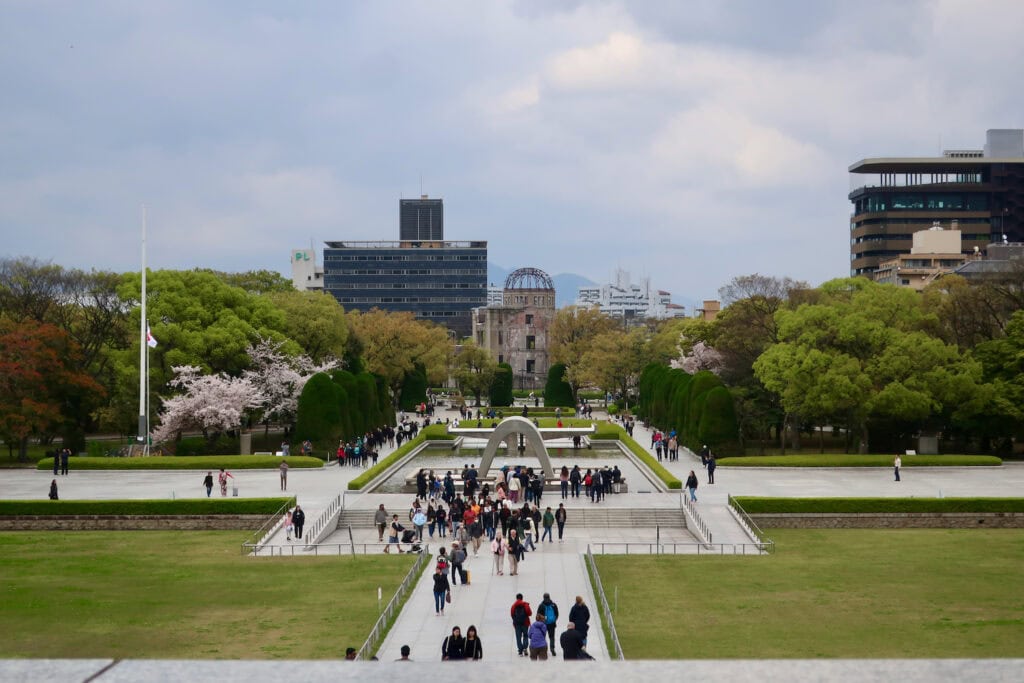
The Japanese parliament later rebuilt the city from the ashes of its total devastation, devising ways to foster community, prosper, and spawn an era of peace despite the deeply felt physical and emotional pain.
Plan to spend at least half-day city in Peace Memorial Park, home to several memorials dedicated to those who perished during the bombing; and inside the midcentury modern designed Peace Memorial Museum, which displays photos and belongings left behind by victims of the attacks.
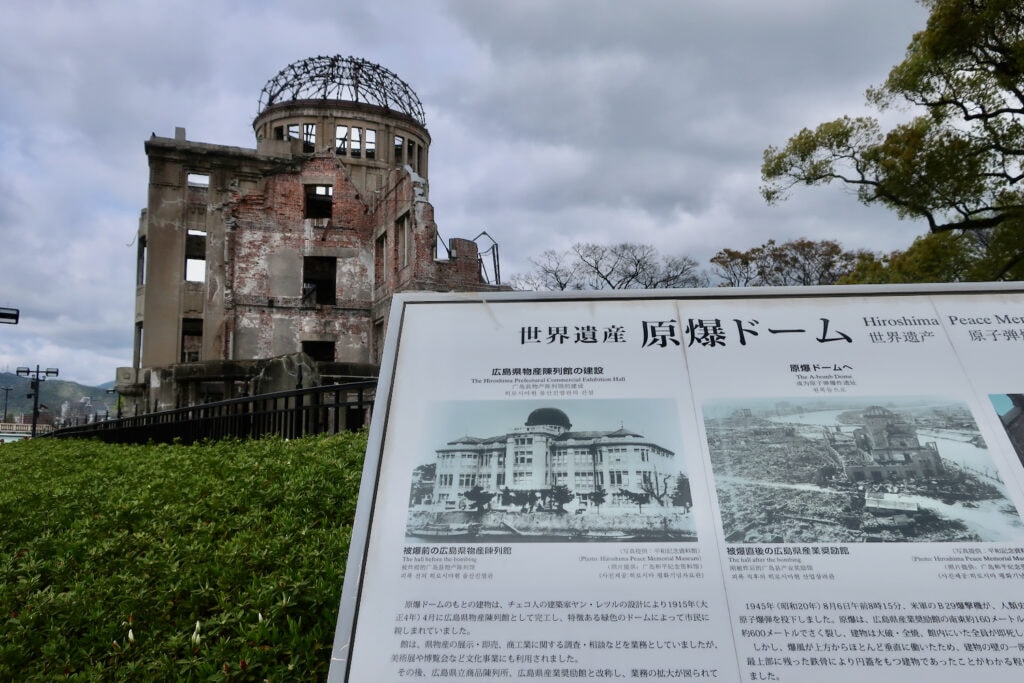
Genbaku Dome
The centerpiece of the Hiroshima Peace Memorial is the Genbaku Dome – the surviving remains of the Hiroshima Prefectural Industrial Promotional Hall – left as it was just after the A-Bomb detonated about 2,000 feet above. All but the steel scaffolding of the dome disintegrated: and that dome, and the parts of the structure that remained, are the defining features of the park.
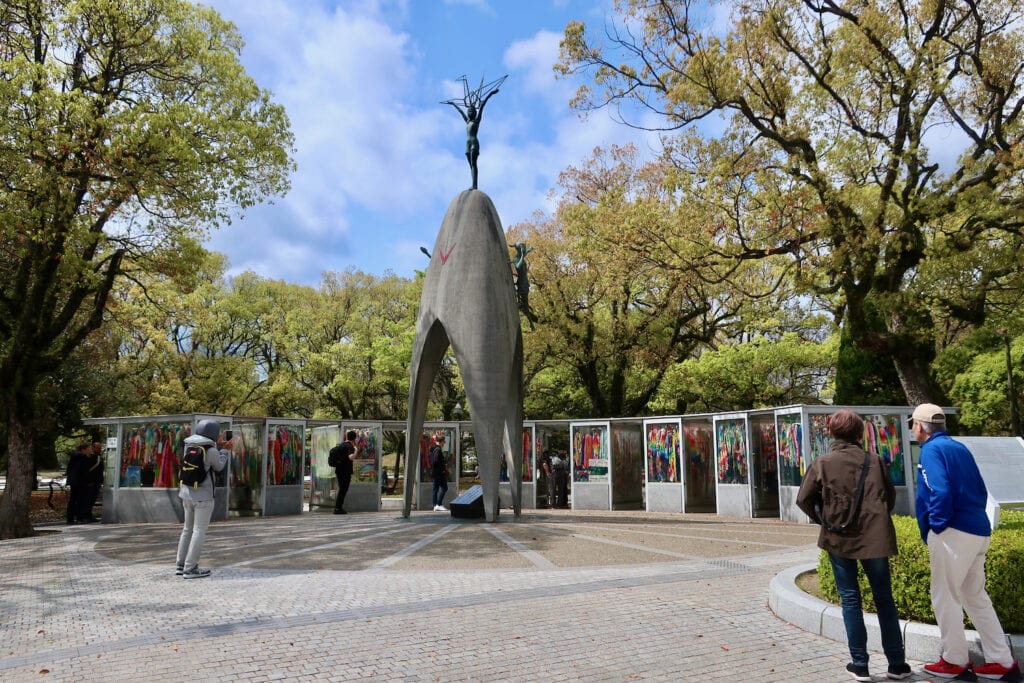
Paper Crane Girl Monument
One of the most compelling monuments is that of Sadako Sasaki, who was blown out of her bedroom window at the age of two on August 6, 1945. Amazingly, Sasaki survived the blast, but ten years later, she was diagnosed with leukemia. A Japanese legend imparts that cranes, a symbol of good fortune and longevity, and said to live a thousand years, will grant a wish to those who make 1,000 origami birds in its likeness. During her painful treatments in the hospital, Sasaki made 1,300 of them. Although she passed away at age 12, her paper cranes became a symbol of peace.
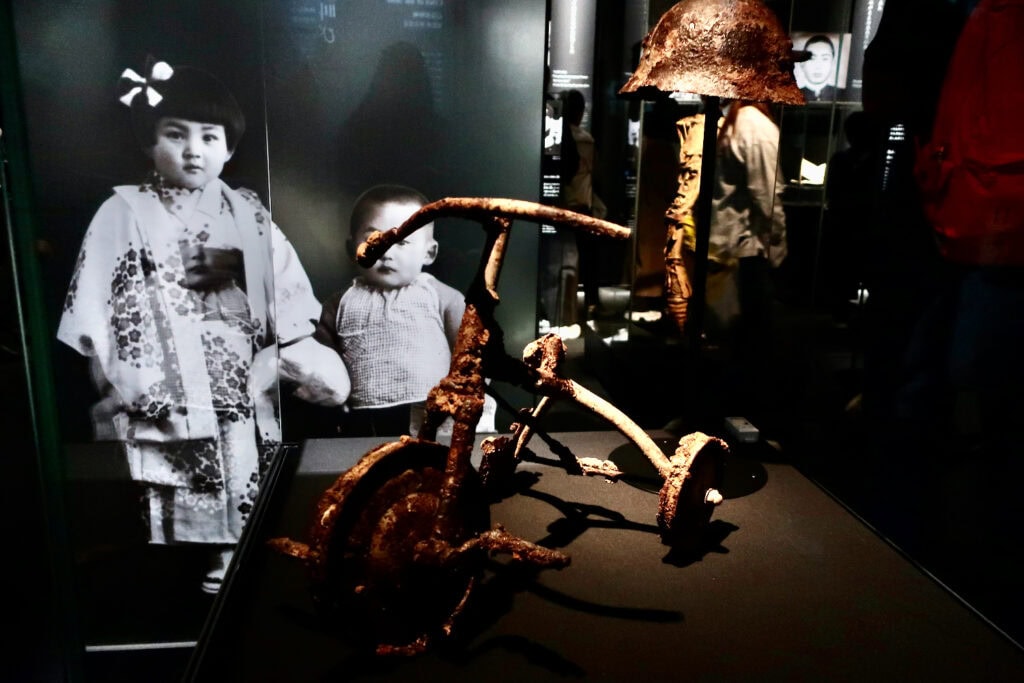
Peace Memorial Museum
Before heading upstairs to the galleries, watch a 22-minute movie for an unsparing look at the dead and dying in the aftermath of the Atomic Bomb blast. You’ll walk away convinced that nuclear bombs should be removed from every arsenal on earth – which is the takeaway, and mission of this museum and park.
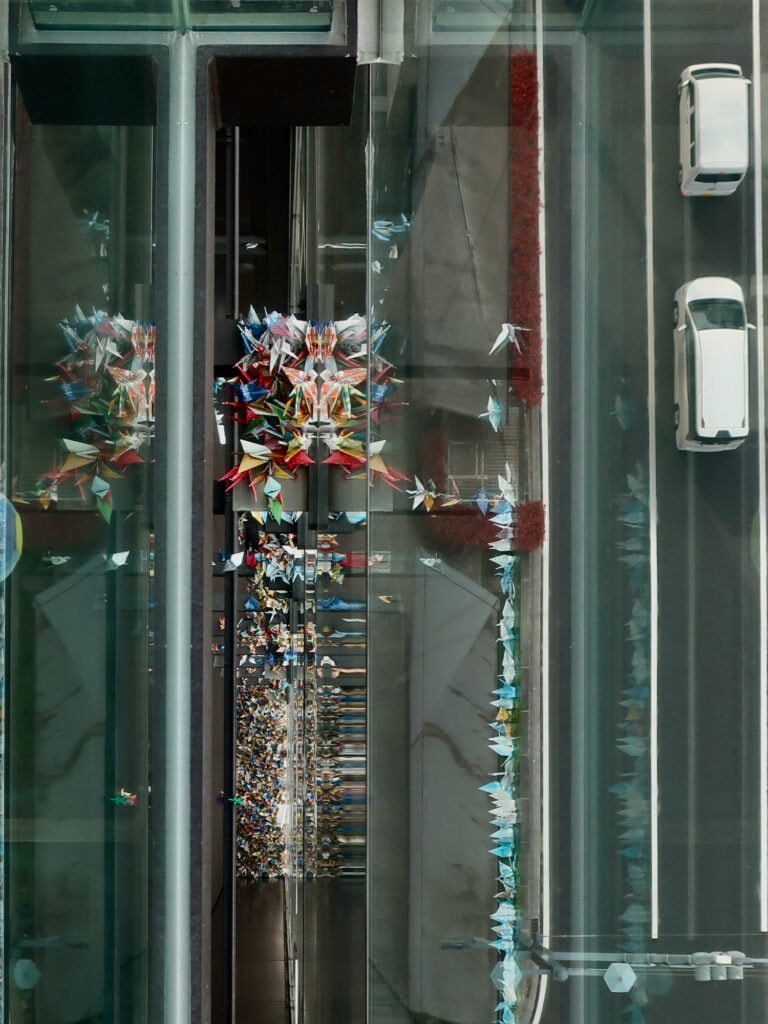
Make Your Own Paper Crane, and Watch It Float Down To Thousands of Others at the Hiroshima Orizuru Tower
First, ascend to the top of the Orizuru Tower for a rooftop overview of Hiroshima and the Peace Park directly below. Next, walk down a ramp to the next floor where you can create your own paper crane (via IPad instruction, or with the help of very patient docents). You can either take your approximation of a crane home with you – or send it down the building-high window wall (that can be seen from the street) where hundreds of thousands have settled before yours.
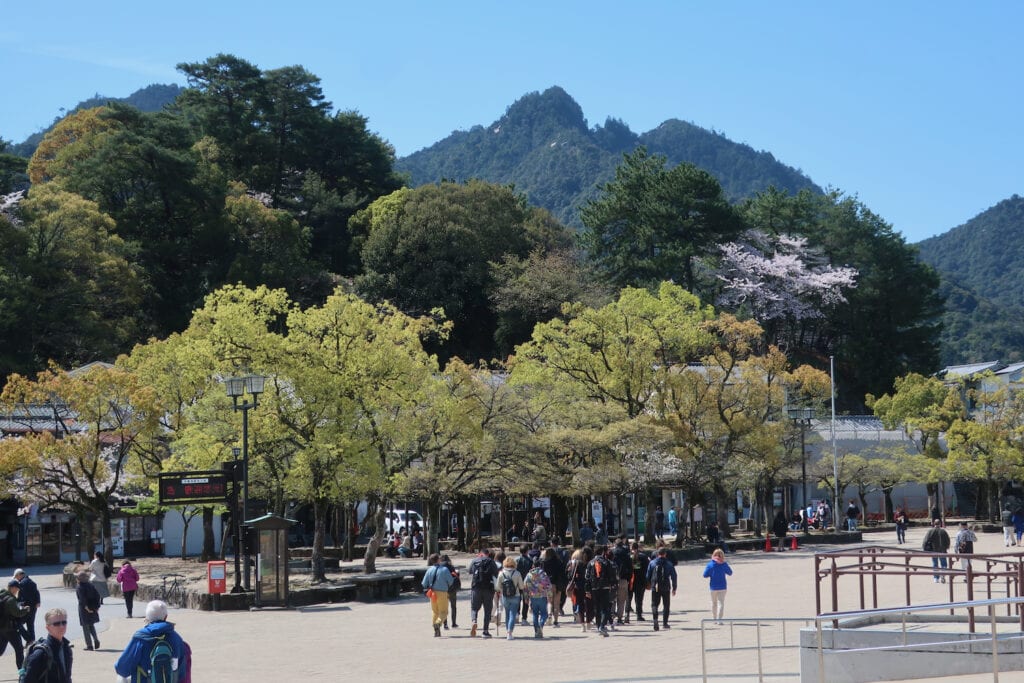
Take the Boat From Hiroshima to Miyajima Island To Meet Friendly Deer, and Visit A Unique Shinto Shrine and Hillside Buddhist Temple
Miyajima Island is a sacred location in the Shinto religion. Legend has it that the first Shinto shrine was built here during the 6th century in honor of the goddess of the ocean, the daughter of the goddess who created Japan itself.
Right outside the ferry terminal – and all over the island, actually – don’t be surprised when deer try to nuzzle you. They’re looking for food, and until recently had been fed until island authorities made it against the law. Now, these poor deers must forage for themselves, but are so used to people, they won’t run away when you come near.
(FYI If you’re looking for the famous friendly deer that have been taught to bow – they are not here. They’re in Nara Park – about an hour outside of Osaka – about a 5 hour drive from Hiroshima).
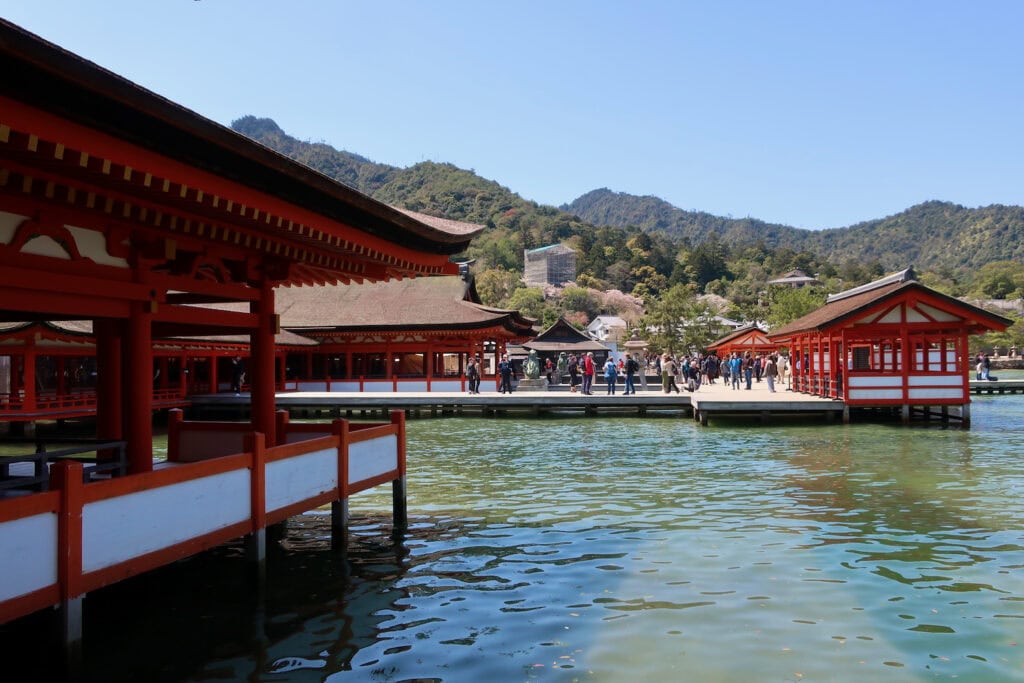
Shinto Shrine Building, Miyajama Island
A humungous orange Shinto Gate sits just offshore. At high tide, it juts from the water. At low tide, you can stroll out on the sandy flats and walk beneath it.
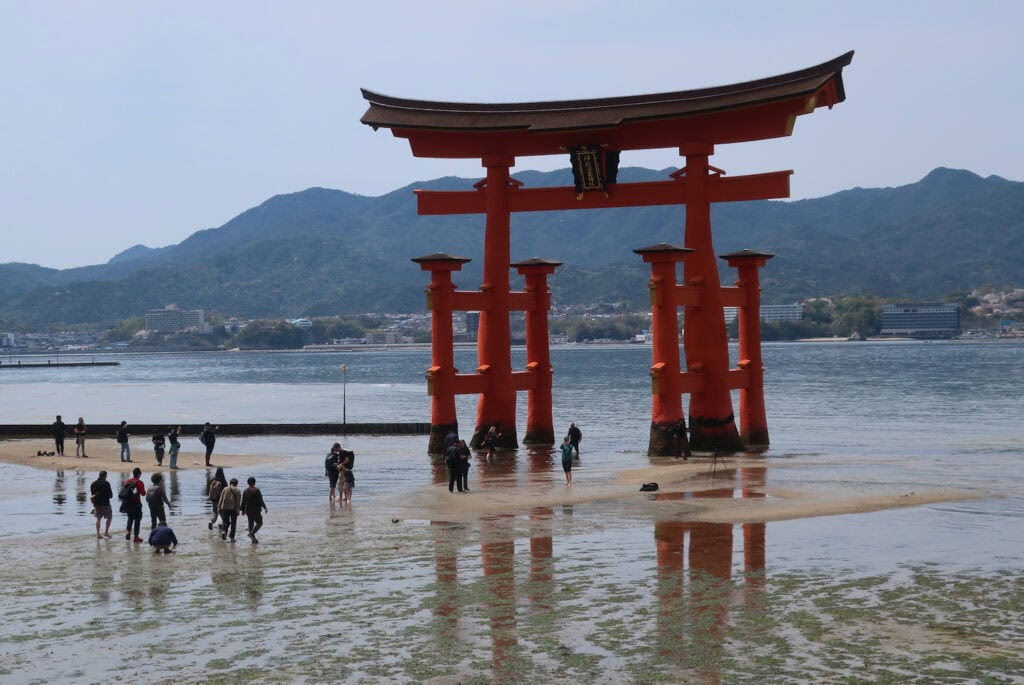
The shrine building itself was built on stilts over water. Overseen by Japan’s version of Neptune, fishing in the sea around this island is prohibited. Walk on boardwalks built with spaces between planks of wood, in order to see the water below.
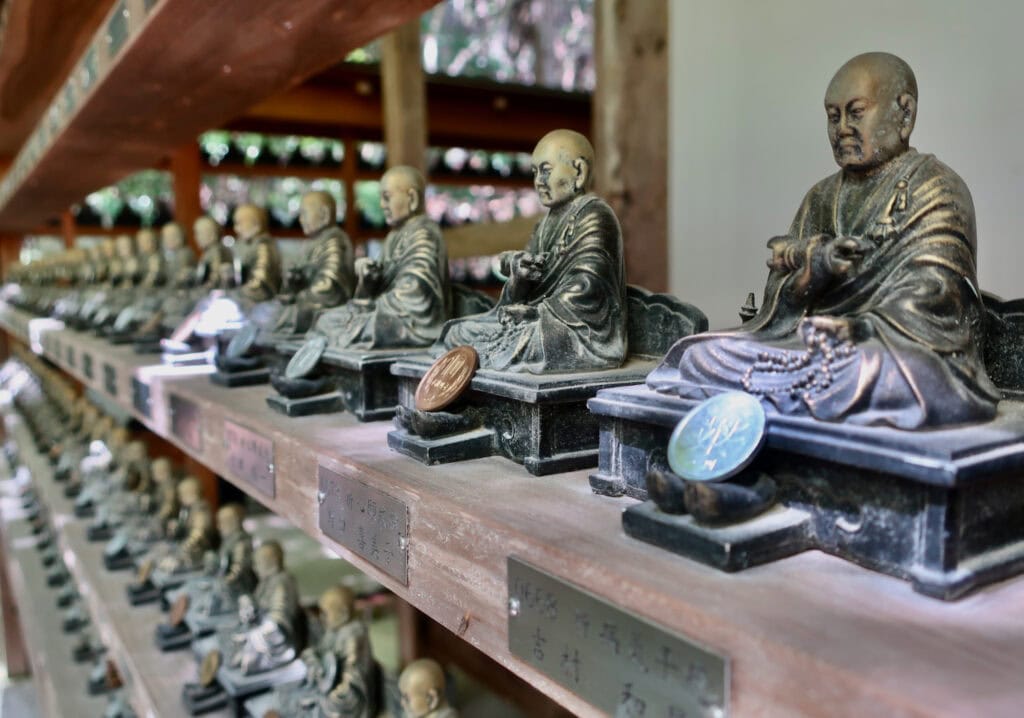
Buddhist Daisho-In Temple
It takes some leg and lung power to climb the steps to the top of the Daisho-In Temple. A Buddhist complex consecrated in 806 CE, the Temple is famous for its eternal flame, said to have been burning for more than 1,200 years.
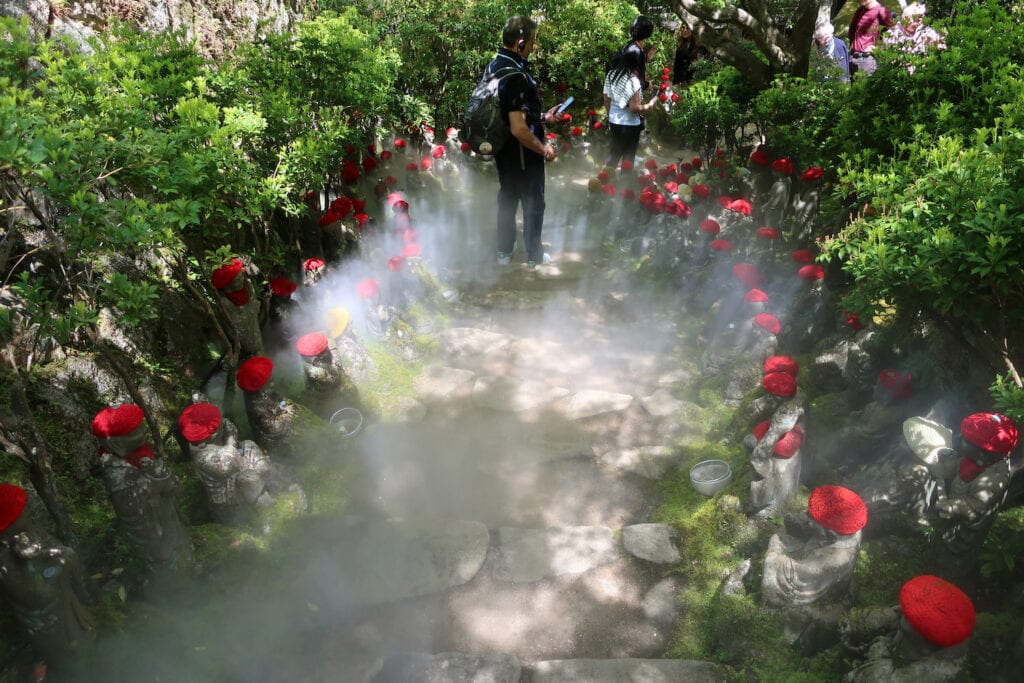
Here’s a plan: walk up the stairs to mid-mountain to ring an ancient gong, and to see arrays of tiny Buddhas – each representing a donor to the place.
Then, walk down a narrow path lined with hundreds of sitting red-capped stone Buddhas – which every so often are obscured by man-made mist. Apparently, patrons make sure that the deities have freshly knitted caps every year to look their finest.
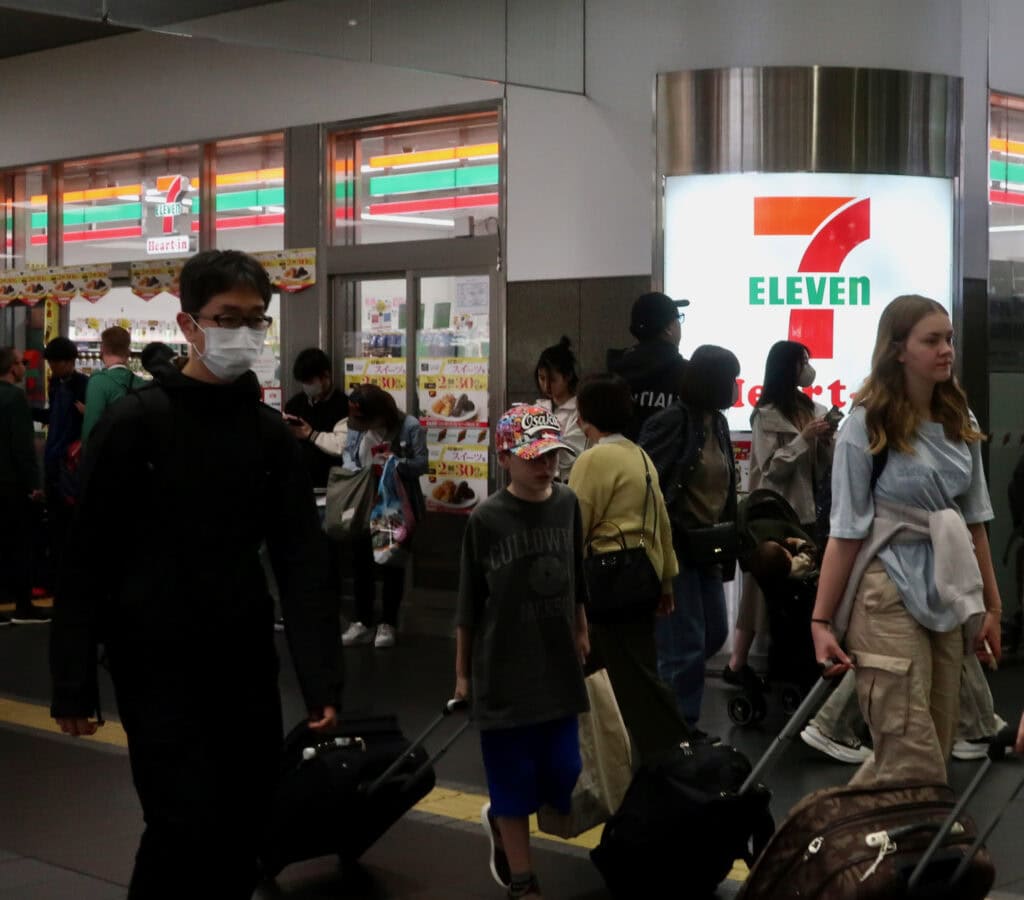
Pick Up A Quick (Cheap) Meal at Any 7-Eleven
There are 7-Eleven stores everywhere in Japan. In fact, there are more in this small country (over 21,000) than in the USA (9,500). And unlike their American counterparts, 7-Elevens in Japan are a go-to for fresh, quick, no-frills meals, street food, snacks, cash (ATMs), sundries, and so much more.. Try the seaweed-covered rice triangles with various fillings (my favorite is tuna-mayo), or Macha Kit Kat bars (available only in Japan). It’s just fun to explore and find new favorites.
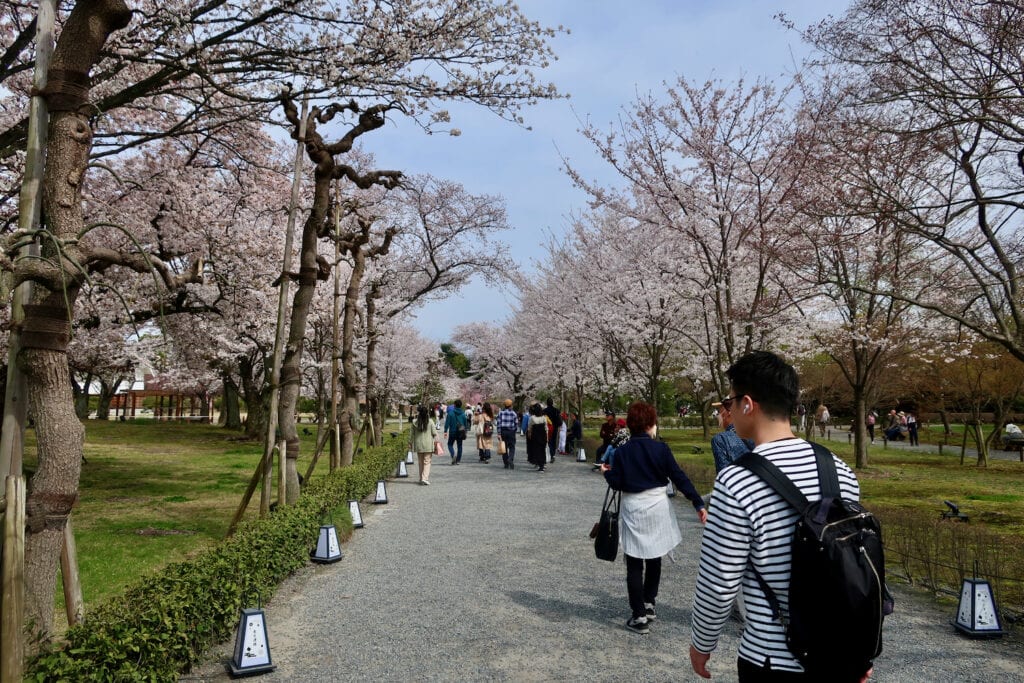
For Those Who Hate To Plan, Book A Curated and Guided Tour
FYI – you can do and see all of the above and more without having to plan it yourself on the Insiders Japan Tour through Odysseys Unlimited (which also plans and books all hotels, trains, and a good number of meals – included in the tour cost).
I paid full price and was not compensated at all – so all of my recommendations are based on what I, as a travel writer, found most impressive and important to see. This is thanks to my great Japanese “insider” guide, Hiroko Kara (“call me Hero”), who steered us to what she finds most impressive and important about her own country: The very best insider to give this kind of advice. And from what I’ve heard from others who have taken this tour at other times, all Odyssey guides are amazing.
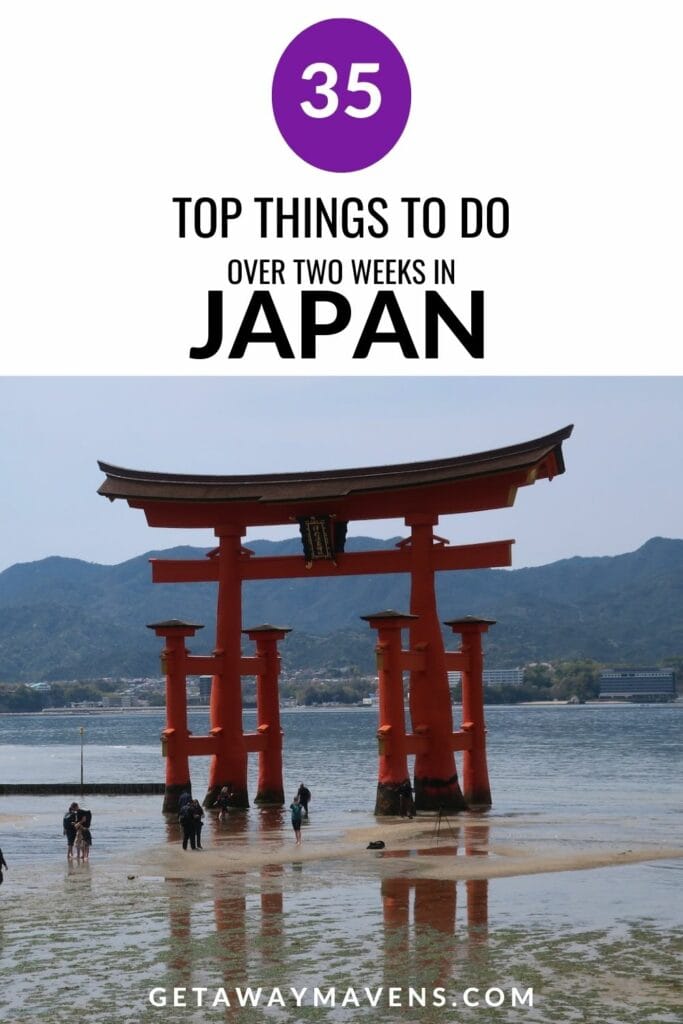

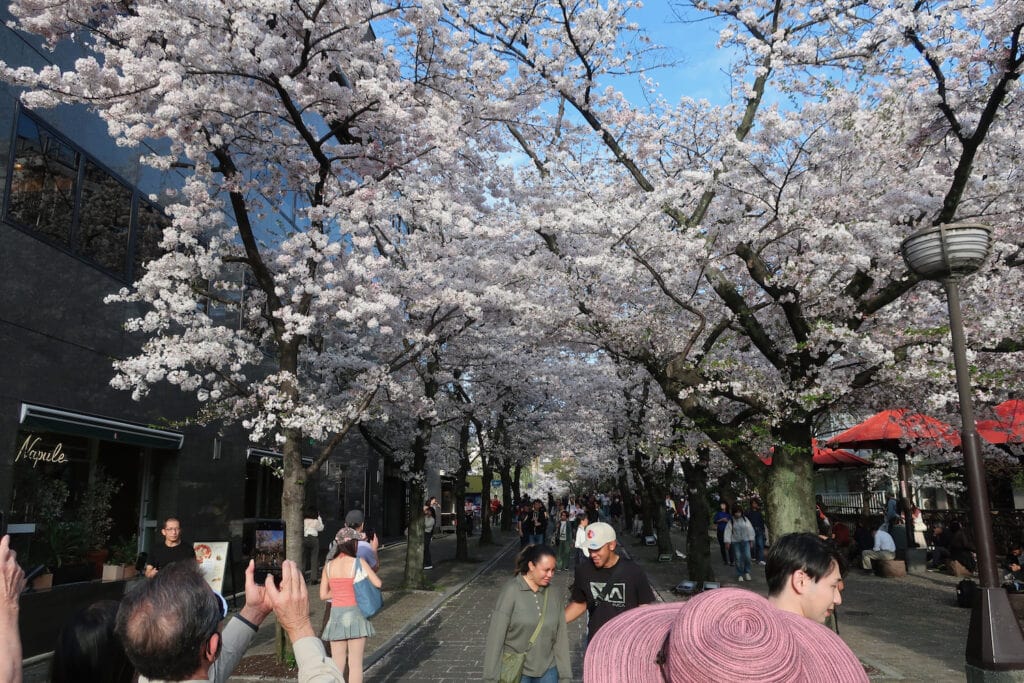

Thank you so very much for putting this together!! You are a very talented lady. Made me fell like I experienced the trip all over again. Many thanks, Mary
This was a great trip and you did a wonderful job hitting the many experiences we had. Thanks for sharing.
Denise Hessler